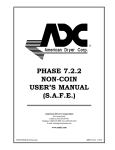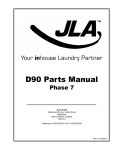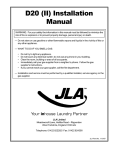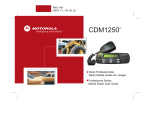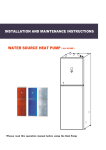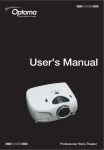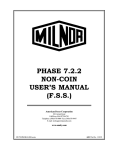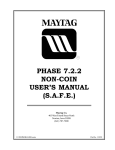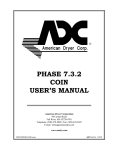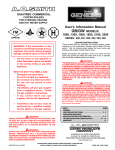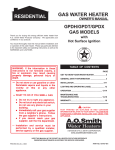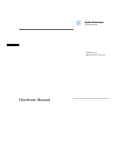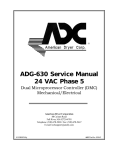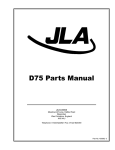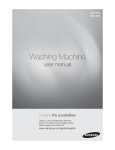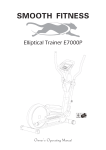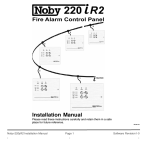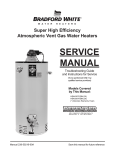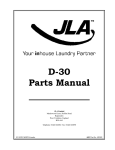Download phase 7.2.2 non-coin user`s manual (safe) - Cost
Transcript
PHASE 7.2.2
NON-COIN
USER’S MANUAL
(S.A.F.E.)
JLA Limited
Meadowcroft Lane, Halifax Road
Ripponden
West Yorkshire, England
HX6 4AJ
Telephone: 01422 822282 / Fax: 01422 824390
090403JMORALES/tcosta
JLA Part No. 113205
Retain This Manual In A Safe Place
For Future Reference
Please read this manual carefully to thoroughly familiarize yourself with the Phase 7 non-coin microprocessor
controller (computer) system features, operational instructions, and programming characteristics. This manual
contains important information on how to employ ALL the features of your new JLA dryer in the safest and
most economical way.
JLA products embody advanced concepts in engineering, design, and safety. If this product is properly
maintained, it will provide many years of safe, efficient, and trouble free operation.
We have tried to make this manual as complete as possible and hope you will find it useful. JLA reserves the
right to make changes from time to time, without notice or obligation, in prices, specifications, colors, and
material, and to change or discontinue models.
NOTE: If power to the dryer is off, the Sensor Activated Fire Extinguishing
(S.A.F.E.) system is disabled.
Table of Contents
SECTION I
INTRODUCTION ................................................................................................ 3
SECTION II
FEATURES .......................................................................................................... 4
A. Dependable Phase 7 Non-Coin Microprocessor Controller (Computer)
Solid State Integrated Circuitry......................................................................................................4
B. Sensor Activated Fire Extinguishing (S.A.F.E.) System...................................................................4
C. Program Changes Are Easily Made At The Keyboard (Touch Pad) ................................................4
D. Automatic Drying Cycle ...............................................................................................................4
E. Timed (Manual) Drying Cycle .......................................................................................................4
F. Preprogrammed Cycles ................................................................................................................4
G. Manually Loaded Cycles ..............................................................................................................4
H. Variable (Programmable) Fabric/Temperature Selections ................................................................4
I. Cool Down/Controlled Cool Down Program ..................................................................................4
J. L.E.D. Display.............................................................................................................................4
K. Wrinkle Guard Program ................................................................................................................4
L. Diagnostics ..................................................................................................................................4
M. Audio Alert Signal ........................................................................................................................4
N. Temperature Conversion Status .....................................................................................................5
O. High Temperature Protection ........................................................................................................5
P. Cycle Preview .............................................................................................................................5
Q. Reversing Option .........................................................................................................................5
R. Rotation Sensor ............................................................................................................................5
S. Clean Lint ....................................................................................................................................5
T. Language Selection ......................................................................................................................5
U. Model Selection ...........................................................................................................................5
V. Default Factory Settings ...............................................................................................................5
W. Keyboard (Touch Pad) Symbols ....................................................................................................5
X. Steam Injection Option .................................................................................................................5
SECTION III
PROGRAM SELECTIONS ................................................................................. 6
A.
B.
C.
D.
E.
F.
G.
H.
I.
J.
K.
L.
M.
Preprogrammed Cycles ................................................................................................................6
Manually Loaded Cycles ..............................................................................................................7
Automatic Drying Cycle Operations ..............................................................................................8
Timed (Manual) Drying Cycle Operation .......................................................................................8
Light Emitting Diode (L.E.D.) Dot Matrix Display .........................................................................8
Cycle In Progress Temperature Display ........................................................................................9
Temperature Conversion Status .....................................................................................................9
Wrinkle Guard Program ................................................................................................................9
Audio Alert On Times 0 to 10 ...................................................................................................... 10
Preprogrammed Cycle Preview .................................................................................................. 10
Reversing Option ....................................................................................................................... 10
Diagnostics ................................................................................................................................ 10
Program Locations ..................................................................................................................... 11
SECTION IV
OPERATING INSTRUCTIONS ....................................................................... 13
A. Operating Sequence ................................................................................................................... 13
B. Operating Notes ......................................................................................................................... 17
C. Sensor Activated Fire Extinguishing (S.A.F.E.) System Theory Of Operation ................................ 18
SECTION V
L.E.D DISPLAY MESSAGES ............................................................................ 21
A. L.E.D. Display Operating Status ................................................................................................. 21
SECTION VI
PROGRAMMING INSTRUCTIONS ............................................................... 22
A. Introduction to Programming ....................................................................................................... 22
B. Programming Flowcharts ............................................................................................................ 24
SECTION VII
FACTORY PRESET PARAMETERS (PROGRAMS) ..................................... 74
A.
B.
C.
D.
Cycle “A-F” Parameters (Programs) Preset By The Factory ....................................................... 74
Cycle “0-40” Parameters (Programs) Preset By The Factory ....................................................... 74
Cycle “A-F” Parameters (Programs) Board Defaults ................................................................... 75
Cycle “0-40” Parameters (Programs) Board Defaults .................................................................. 75
SECTION VIII
PHASE 7 NON-COIN MICROPROCESSOR CONTROLLER
(COMPUTER) PROGRAMMING LIMITS ..................................................... 76
A. Preprogrammed Cycles .............................................................................................................. 76
B. System Parameters (Program Locations) .................................................................................... 77
C. Fixed Parameters ....................................................................................................................... 77
SECTION IX
PHASE 7 NON-COIN MICROPROCESSOR CONTROLLER
(COMPUTER) AUTO CYCLE ADJUSTMENT VALUES ............................... 78
SECTION X
PHASE 7 NON-COIN MICROPROCESSOR CONTROLLER
(COMPUTER) SYSTEM DIAGNOSTICS ....................................................... 79
A.
B.
C.
D.
Diagnostic (L.E.D. Display) Fault Messages ............................................................................... 79
S.A.F.E. System Diagnostic Conditions ....................................................................................... 82
Input/Output (I/O) Board Light Emitting Diode (L.E.D.) Indicators ............................................... 83
Keyboard (Touch Pad) Layout .................................................................................................... 84
SECTION XI
CUSTOMER CUSTOM PARAMETER SETTINGS ....................................... 86
SECTION I
INTRODUCTION
Phase 7 Non-Coin Microprocessor Controller (Computer) Drying System
The Phase 7 Non-Coin Microprocessor Controller (Computer) Drying System has been designed with super
performance in mind to provide for better temperature regulation, efficiency, performance, consistency, and
faster drying times.
Among its many amenities, the Phase 7 Non-Coin Microprocessor Controller (Computer) Drying System has a
true Automatic Drying Cycle. The Phase 7 Non-Coin Microprocessor Controller (Computer) Automatic Drying
Cycle principle is based on one (1) of the most fundamental laws of thermodynamics, which governs the flow of
heat in thermal systems.
Utilizing this Phase 7 non-coin microprocessor controller (computer) technology, the user simply has to place the
load in the dryer and push one (1) single button to start the drying cycle. The Phase 7 non-coin microprocessor
controller (computer) will directly monitor the moisture content in the load and stop the drying cycle automatically
when the selected dryness level is reached.
The Phase 7 Non-Coin Microprocessor Controller (Computer) Automatic Drying Cycle virtually eliminates
ALL guesswork. The Phase 7 non-coin microprocessor controller (computer) determines how much drying
time is needed and compensates for various types of fabrics and load sizes, therefore, avoiding damage to
fabrics by overdrying, as well as avoiding wasted time and energy for any given load. Once the Phase 7
non-coin microprocessor controller (computer) determines that the load is dry, the Phase 7 non-coin microprocessor
controller (computer) will go into the Cool Down Cycle until the preprogrammed time or temperature is reached,
and then will shut the dryer off automatically.
113205-2
JLA Limited
3
SECTION II
FEATURES
A. Dependable Phase 7 Non-Coin Microprocessor Controller (Computer) Solid State Integrated
Circuitry Eliminates as many moving parts as possible.
B. Sensor Activated Fire Extinguishing (S.A.F.E.) System A standard feature, which continually monitors
the basket (tumbler) for fires. In the event of a fire, the water supply to the basket (tumbler) will suppress
the fire. The Phase 7 non-coin microprocessor controller (computer) will also notify the user that a fire has
occurred.
C. Program Changes Are Easily Made At The Keyboard (Touch Pad) Actual programs are viewed at
the light emitting diode (L.E.D.) display for verification.
D. Automatic Drying Cycle Computerized monitoring of load dryness for precise, fast, and efficient drying.
E. Timed (Manual) Drying Cycle For special loads, programming allows for a specific amount of time in
minutes, for both drying and Cool Down Cycles.
F. Preprogrammed Cycles The Phase 7 non-coin microprocessor controller (computer) can store in its
memory six (6) preprogrammed cycles in either the Automatic Drying Mode or Manual Drying Mode in the
A-F keys, and an additional 41 in the numerical memory of 0-40.
G. Manually Loaded Cycles For occasional special loads, the user can set a specific program in either the
Automatic Drying Cycle or the Manual Timed Drying Cycle.
H. Variable (Programmable) Fabric/Temperature Selections Accommodates the type of fabric to be
dried.
I. Cool Down/Controlled Cool Down Program Cool down lowers the temperature of the exhaust to
make the material cool enough to handle. Controlled cool down slowly lowers the temperature over 10
minutes for materials sensitive to shrinking.
J. L.E.D. Display Informs user of cycle status, programs, and displays important diagnostic and fault codes.
K. Wrinkle Guard Program Helps keep items wrinkle-free when they are not removed from the dryer
promptly at the end of the drying and cooling cycles.
L. Diagnostics Major circuits, including the door switch(es), Phase 7 non-coin microprocessor controller
(computer) temperature sensor, and heat output circuits, are individually monitored, providing precise messages
for the particular failure.
M. Audio Alert Signal The tone will sound at the end of a complete drying cycle, at a 1-second rate for the
duration programmed. It will also sound for any fault conditions at a quarter second rate for 4-beeps. Finally,
there is a 3-beep warning at the beginning of every Wrinkle Guard On Cycle; a continuous rapid pulse is
used for the entire duration of S.A.F.E. system activation. A connection is also available to install an external
24Vdc (volts direct current) buzzer or relay with a maximum power consumption of 250 mA (milliamperes).
4
JLA Limited
113205-2
N. Temperature Conversion Status Temperature-related programs can be set in either Fahrenheit (°F) or
Celsius (°C). ALL temperatures will automatically convert to the corresponding values (+/- 1°) when
changes are made.
O. High Temperature Protection If the Phase 7 non-coin microprocessor controller (computer) senses
that the temperature in the basket (tumbler) has exceeded 180° F (82° C) for axial airflow, or 220° F
(104° C) for radial airflow, it will end the drying cycle and a fault code will be displayed, indicating an
overheating problem.
P. Cycle Preview Entire dryer parameters (programs), or the preprogrammed cycles, are displayed for
verification upon a coded entry to the keyboard (touch pad).
Q. Reversing Option Helps reduce the balling up or tangling of large items. A cycle can be set to have the
reversing option, so that the basket (tumbler) will turn in the forward direction for 30- to 120-seconds, stop
for 5- to 10-seconds, and then proceed in the reverse direction for the same time. This process is repeated
throughout the drying and cooling cycles.
R. Rotation Sensor The Phase 7 non-coin microprocessor controller (computer) also displays basket (tumbler)
rotations per minute (RPM) by pressing and holding the DOWN ARROW key while the basket (tumbler)
is on. (The basket [tumbler] must be rotating for approximately 30-seconds before getting a true RPM
reading).
S. Clean Lint This feature monitors the value of the Lint Cleaning Frequency timer. The timer keeps track
of how long the dryers blower/fan has been on, and compares it to the Lint Cleaning Frequency Setting.
Once the timer equals the Lint Cleaning Frequency setting, the Phase 7 non-coin microprocessor controller
(computer) will begin to prompt the user to CLEAN LINT. The Phase 7 non-coin microprocessor controller
(computer) will allow two (2) additional hours of run time before the Phase 7 non-coin microprocessor
controller (computer) is locked-out in a CLEAN LINT state. The dryer will not be cleared from this state
until the lint drawer has been cleaned. When the lint drawer is opened, the display will read Lint Access
Open, and when the lint drawer is closed, the display will read READY.
T. Language Selection The Phase 7 non-coin microprocessor controller (computer) has the ability to display
five (5) different languages: English, French, Spanish, Italian, and German.
U. Model Selection The Phase 7 non-coin microprocessor controller (computer) can be programmed to be
used on three (3) modes of heat: gas, steam, and electric. It can also be configured for reversing and
non-reversing dryers.
V. Default Factory Settings This feature will set ALL programmed parameters to their default values.
W. Keyboard (Touch Pad) Symbols
= STOP/CLEAR key
= START/ENTER key
= UP ARROW key (scroll up)
= DOWN ARROW key (scroll down)
X. Steam Injection Option The Phase 7 non-coin microprocessor controller (computer) has the ability to
program up to five (5) steam injection intervals, for a programmed amount of time, at different points of a
cycle including cool down.
113205-2
JLA Limited
5
SECTION III
PROGRAM SELECTIONS
A. PREPROGRAMMED CYCLES
A-F CYCLES
The Phase 7 non-coin microprocessor controller (computer) can store in its memory six (6) preprogrammed
cycles (keys A-F on the keyboard [touch pad]). This allows the user to have the six (6) most commonly used
cycles readily available, requiring only the push of a single keyboard (touch pad) entry to start the dryer.
0-40 CYCLES
The Phase 7 non-coin microprocessor controller (computer) can store 41 preprogrammed cycles in its numerical
memory. (Use keys 0-9 on the keyboard [touch pad]). This allows the user to have up to 41 customized
programmed cycles that may not be as commonly used as the six (6) A-F. These are not one-touch entries to
start the dryer like A-F. They are selected by entering the number, which represents the cycle desired, and by
pressing the START/ENTER key to start the cycle.
Both types of preprogrammed cycles can be set in either the Automatic Drying Mode, in which the drying cycle
will end when the selected dryness level has been reached, the drying time out time has expired, or in the Manual
Timed Drying Mode, in which the dryer will operate for the specific drying time programmed. These cycles can
be programmed in any combination.
Once the heating cycle is completed, the Phase 7 non-coin microprocessor controller (computer) then goes into
the Cool Down Cycle in which the articles are tumbled at room temperature or a controlled cool down in which
the dryer goes into a slow Cool Down Mode for 10 minutes sloping the temperature 10° F (5.5° C) every minute.
When the cooling cycle is completed, the dryer will go into the Wrinkle Guard Cycle. For the first 15 minutes of
WRINKLE GUARD, the Phase 7 non-coin microprocessor controller (computer) will remain idle with the
display reading CYCLE DONE. After the 15 minutes have elapsed, the Phase 7 non-coin microprocessor
controller (computer) will beep three (3) times and will activate the basket (tumbler) for 15-seconds without
heat. At this point, the display will read WRINKLE GUARD. Once the 15-seconds are over, the Phase 7
non-coin microprocessor controller (computer) will display CYCLE DONE and will remain idle for 5 minutes,
at which point the Phase 7 non-coin microprocessor controller (computer) will reactivate the basket (tumbler)
for 15-seconds while displaying Wrinkle Guard. The Phase 7 non-coin microprocessor controller (computer)
will continue with the process of 15-seconds ON, 5 minutes OFF, until either the doors are opened, the
STOP/CLEAR
key is pressed, or 99 minutes have elapsed, whichever comes first. Once the Wrinkle
Guard routine has ended, the display will read CYCLE DONE. At this point, the dryer is locked out from
drying again until the doors are opened. This will ensure that if a cycle has been completed, the operator will
attend to it before starting another heat cycle.
NOTE: To enter program mode, press STOP/CLEAR
and UP ARROW
.
PREPROGRAMMED CYCLE MENU SELECTIONS (CYCLES A-F or 0-40):
1. Automatic Drying Cycle
a. The Phase 7 non-coin microprocessor controller (computer) can be programmed to reverse or not
reverse. This is done in the DRYER SETUP parameter.
6
JLA Limited
113205-2
b. Drying Temperature Programmable from 160° F to 200° F (71° C to 93° C,), in one-degree increments,
and preset at 160° F (71° C) for axial dryers.
c. Dryness Level Programmable for FINISHING, DRY, AND EXTRA DRY.
d. Cool Down Time Programmable from 0 to 99 minutes, in 1 minute increments.
e. Cool Down Temperature Programmable from 70° F to 100° F (21° C to 38° C), in one-degree
increments.
f. Cycle Adjustment Programmable from 0 to 99.
2. Timed (Manual) Cycle
a. The Phase 7 non-coin microprocessor controller (computer) can be programmed to reverse or not
reverse. This is done in the DRYER SETUP parameter.
b. Drying Time Programmable from 0 to 99 minutes, in 1 minute increments.
c. Drying Temperature Programmable from 100° F to 200° F (38° C to 93° C) in one-degree increments
for a radial dryer, and 100° F to 160° F (38° C to 71° C) in one-degree increments for an axial dryer.
d. Cool Down Time Programmable from 0 to 99 minutes, in 1 minute increments.
e. Cool Down Temperature Programmable from 70° F to 100° F (21° C to 38° C), in one-degree
increments.
f. The Spin Time can be programmed from 30-seconds to 120-seconds, in 1-second increments.
g. The Dwell (Stop) Time can be programmed from 5-seconds to 10-seconds, in 1-second increments.
h. Steam Injection (Optional) Programmable 0-5 intervals.
ALL six (6) A-F preprogrammed cycles, along with cycles 0-40, have been programmed by the
factory as outlined in Section VII. However, even though cycles A-F are the most common cycles
used, they should be reviewed to ensure they meet the location application or needs. Should changes
become necessary, refer to the Programming Section of this manual.
B. MANUALLY LOADED CYCLES
For occasional or onetime special loads, the operator must enter the specific program features needed. This
cycle is not stored within the Phase 7 non-coin microprocessor controller (computer) and must be entered each
time.
The Manually Loaded Cycle can be set in either the Automatic Drying Mode or the Timed (Manual) Drying
Mode. These modes are selected by pressing the AUTO or MAN key on the keyboard (touch pad).
113205-2
JLA Limited
7
C. AUTOMATIC DRYING CYCLE OPERATIONS
In this mode, the Phase 7 non-coin microprocessor controller (computer) determines how much drying time is
needed and compensates for various types of fabrics and load sizes, ALL automatically. The Phase 7 non-coin
microprocessor controller (computer) accomplishes this by calculating the dryness level (percentage of extraction),
using the temperature selected, as well as the dryness level preset by the factory.
The Phase 7 non-coin microprocessor controller (computer) monitors the first three (3) heat peaks (slopes), at
which time it calculates the dryness level (heat loss), along with the percentage of extraction selected. When the
Phase 7 non-coin microprocessor controller (computer) determines that ALL the factors are met, the drying
cycle will end and the dryer will go into the Cool Down Cycle. The Phase 7 non-coin microprocessor controller
(computer) also has a drying time out setting, which will control the maximum time an auto cycle will run.
D. TIMED (MANUAL) DRYING CYCLE OPERATION
This drying cycle is intended for special loads in which a specific amount of drying time and cooling time is
needed. It is especially intended for fine, delicate items that require very low temperatures and long drying
and/or Cool Down Time periods.
ALL parameters set in the COOL DOWN SETUP pertain to the Manually Loaded Manual and Auto Cycles.
The A-F and 0-40 cycles that have been selected to be manual, have separate settings for ALL the parameters
contained in the COOL DOWN SETUP menu.
The program limitation is the same as in Section III, A2.
NOTE: The Cool Down Cycle will either run until the Cool Down Temperature is reached or until the
Cool Down Time has expired, whichever comes first.
NOTE: If no Drying Time has been selected, the Cool Down Cycle will ignore the Cool Down
Temperature and will use the Cool Down Time only.
E. LIGHT EMITTING DIODE (L.E.D.) DOT MATRIX DISPLAY
The L.E.D. display informs the user of cycle status, program verification, and displays important diagnostic and
fault information. A complete listing of the various display messages and their meanings is shown in Section V
of this manual.
CYCLE IN PROGRESS DISPLAY STATUS
During the Drying Cycle, the display will indicate the type of cycle in progress by presenting either one (1) of the
following:
1. AUTO DRYING CYCLE Manually Loaded Auto Cycle.
2. AUTO DRYING CYCLE # The # is replaced with A-F or 0-40.
3. MANUAL DRYING CYCLE Manually Loaded Manual Cycle.
4. MANUAL DRYING CYCLE # The # is replaced with A-F or 0-40.
8
JLA Limited
113205-2
F. CYCLE IN PROGRESS TEMPERATURE DISPLAY
While the dryer cycle is in progress, the temperature in the basket (tumbler) can be displayed by pressing and
holding the UP ARROW key. The temperature will be displayed in either Fahrenheit (°F) or Celsius (°C),
depending on which temperature system has been set in the DRYER SETUP.
G. TEMPERATURE CONVERSION STATUS
Temperature related programs are programmable to be operated in either Fahrenheit (°F) or Celsius (°C). The
temperature selection is made in SYSTEM TEMP. The programs affected are as follows:
1. Temperature Display Mode
2. Drying Temperatures
3. Cool Down Temperatures
IMPORTANT: When changing the temperature conversion status from Fahrenheit to Celsius, or vice
versa, ALL of the Temperature Selections and Cool Down Temperatures will be
changed accordingly. The Phase 7 non-coin microprocessor controller (computer)
automatically calculates and converts the temperatures in these programs to the
previously set value. For example, if the preprogrammed Cycle A drying
temperature was set for 160° F, when converting from °F to °C, the Phase 7 non-coin
microprocessor controller (computer) will change to 71° C (+/- 1° Celsius).
H. WRINKLE GUARD PROGRAM
This program keeps items wrinkle-free when they are not removed from the dryer promptly at the end of the
drying and/or cooling cycles.
When the drying and cooling cycles are completed, the dryer will shut off, the tone will sound, and the light
emitting diode (L.E.D.) display will read CYCLE DONE. If the door is not opened or the cycled stopped, the
Phase 7 non-coin microprocessor controller (computer) will wait an initial 15 minutes delay time. Once the initial
15 minutes of delay time have expired, the fan will start and the basket (tumbler) will rotate (without heat) for an
ON time of 15-seconds. When the fan and basket (tumbler) start, the display will read WRINKLE GUARD.
Immediately following the 15-second ON time, the Phase 7 non-coin microprocessor controller (computer)
will go into a 5 minute OFF time, at which point it will display CYCLE DONE. The Phase 7 non-coin
microprocessor controller (computer) will repeat this process of 15-seconds ON and 5 minutes OFF until
key is pressed, or 99 minutes has elapsed, whichever
either the doors are opened, the STOP/CLEAR
comes first. Prior to each ON time, there is a 3-beep warning that the fan and basket (tumbler) rotation are
about to start. The beeps at the end of the Wrinkle Guard Cycle can be programmed to be ON/OFF. This is
done in the WRINKLE GUARD SETUP.
WRINKLE GUARD PROGRAM SELECTION:
Wrinkle Guard Audio Alert On/Off
The operator can select to turn the beeps on or off at the end of each Wrinkle Guard Cycle. The number of
beeps is programmed in AUDIO ALERT ON TIMES.
113205-2
JLA Limited
9
I. AUDIO ALERT ON TIMES 0 TO 10
The tone will sound at the end of the Cool Down Cycle to indicate that the cycle is complete. Programming
allows for the elimination of the tone during the Wrinkle Guard Cycle. This is done in the WRINKLE GUARD
SETUP. Programming also allows the beeps to be set from 0 to 10 beeps in increments of one (1). This is done
in DRYER SETUP.
J. PREPROGRAMMED CYCLE PREVIEW
The parameters of the preprogrammed cycles can be displayed for verification. To view an A-F preset
program (parameter), simply press the START/ENTER key and the desired preset program A-F. The
light emitting diode (L.E.D.) display will read the program parameter settings, then return to the READY
display mode. To view a 0-40 preset program parameter, simply press the START/ENTER key and the
desired preset program number 0-40 followed by the START/ENTER key again. The L.E.D. display will
read the program parameter settings, and then return to the READY display mode.
K. REVERSING OPTION
This feature helps reduce balling-up or tangling of large items.
REVERSING OPTION SELECTIONS:
1. Reverse On or Reverse Off
2. This option can be set to ON or OFF for each cycle individually.
3. Basket (Tumbler) Spin Time and Dwell (Stop) Time
a. Fixed in the Automatic AUTO Mode and cannot be changed.
1) Spin Time 2 minutes forward and 2 minutes reverse.
2) Dwell (Stop) Time 5-seconds.
b. Programmable in the Manual Mode.
1) Spin Time Programmable from 30-seconds to 120-seconds, in 1-second increments.
2) Dwell (Stop) Time Programmable from 5-seconds to 10-seconds, in 1-second increments.
L. DIAGNOSTICS
The Phase 7 non-coin microprocessor controller (computer) monitors the Drying Functions, which include
temperatures, burners, sail switches, blower, basket (tumbler), and lint drawer.
10
JLA Limited
113205-2
M. PROGRAM LOCATIONS
System parameters are programmed in Program Locations (PL). Access to this location is acquired by pressing
the STOP/CLEAR and the UP ARROW together. To exit the Programming Location, simply press
the STOP/CLEAR key. If you are several menu layers deep, continue to press the STOP/CLEAR
key to back up the menu until you are ALL the way out of the programming mode.
0. SELECT LANGUAGE This menu allows the selection of five (5) different languages to operate the
dryer. The language that is selected will be used for every displayed message as well as for faults and
menus.
ENGLISH
FRANCAIS
ESPANOL
ITALIANO
DEUTSCH
1. SELECT SYSTEM PARAMETERS This menu level has four (4) sections. ALL programmable
parameters, other than preprogrammed cycles, are done here.
0. DRYER SETUP ALL parameters that pertain to drying are in this menu level.
0. SELECT MODEL This allows the selection of the heat source applied to the dryer, and whether
the dryer is reversing or non-reversing.
GAS REVERSING
STEAM REVERSING
ELECTRIC REVERSING
GAS NON-REVERSING
STEAM NON-REVERSING
ELECTRIC NON-REVERSING
1. SYSTEM TEMP This selection controls whether the temperature related programs will be operated
in Fahrenheit (°F) or Celsius (°C). The programs affected are as follows:
1) Temperature Display Mode
2) Drying Temperatures
3) Cool Down Temperatures
IMPORTANT: The Phase 7 non-coin microprocessor controller (computer) automatically calculates
and converts the temperatures in these programs to the previously set value. For
example, when changing from °F to °C, if the preprogrammed Cycle A drying
temperature was set for 160° F, the Phase 7 non-coin microprocessor controller
(computer) will change to 71° C (+/- 1° Celsius).
2. ENTER LINT CLEANING FREQUENCY 1 TO 10 HOURS This selection sets how long the
lint cleaning timer will run before prompting the user to CLEAN LINT. Once the user is prompted
to CLEAN LINT, the Phase 7 non-coin microprocessor controller (computer) will allow an
additional 2 hours of run time before the dryer is placed into a locked-out state, waiting for the lint
drawer to be cleaned.
3. ENTER AUDIO ALERT ON TIMES 0 TO 10 This selection allows the operator to adjust the
amount of signal tones. This parameter (program) affects the tone at the end of the Cool Down
Cycle, as well as at the end of the Wrinkle Guard On Time.
113205-2
JLA Limited
11
4. ROTATION SENSOR This selection is used to turn the rotational sensor on or off.
5. BOARD ADDRESS 00 TO ZZ This location is where the board address is defined. This is only
used when the Phase 7 non-coin microprocessor controller (computer) is interfaced to a network.
6. AUTO CYCLE TIME OUT 0 TO 99 MINUTES This selection allows the user to set a maximum
time that the auto cycle will run before timing out.
1. REVERSING SETUP The parameters that pertain to the reversing mode are in this menu level.
0. ENTER SPIN TIME 30 TO 120 SECONDS This parameter (program) is fixed at 2 minutes in the
forward direction and 2 minutes in the reverse direction for the Automatic Mode. In the Manual Mode,
it is programmable. This Spin Time is programmed here for the Manually Loaded Manual Cycle only.
1. ENTER STOP TIME 5 TO 10 SECONDS This parameter (program) is fixed at 5-seconds in the
Automatic Mode and programmable in the Manual Mode. This Dwell (Stop) Time is programmed here
for the Manually Loaded Manual Cycle only.
2. WRINKLE GUARD SETUP The parameters that pertain to the Wrinkle Guard are in this menu level.
0. WRINKLE GUARD AUDIO ALERT This parameter (program) allows the operator to turn the
Audio Alert tone on or off at the end of each Wrinkle Guard Cycle.
AUDIO ALERT ON
AUDIO ALERT OFF
3. STEAM INJECTION SETUP (Optional) This parameter is used to inject steam into the basket
(tumbler) up to 5 times. 0-5 ON time is first entered MM:SS (minutes:seconds), and then the OFF time
is entered MM:SS (minutes:seconds).
2. PROGRAM A-F CYCLES This menu allows the programming of cycles A-F. The parameters
selected in this menu for each letter will be stored in memory for that key. This will allow the operator to
utilize one-touch drying through keys A-F.
3. PROGRAM 0-40 CYCLES This menu allows the programming of cycles 0-40. The parameters
selected in this menu for each number will be stored in memory for that number key(s). This will allow the
operator to utilize preprogrammed drying cycles stored in memory under a numerical location.
NOTE: BOTH THE A-F and 0-40 CYCLES ALLOW FOR A TOTAL OF 47
PREPROGRAMMED LOCATIONS FOR CUSTOM DRYING.
4. DEFAULT SETTINGS This menu allows the operator to set ALL programmable parameters to default
settings. This option has a password selection of 1 2 3. It will then ask to confirm settings. It will default
to NO. Use the arrow keys to select YES.
CAUTION: Once the settings have been set to their default settings, there is no way to
retrieve the old settings. Use caution when using this feature.
12
JLA Limited
113205-2
SECTION IV
OPERATING INSTRUCTIONS
The Phase 7 non-coin microprocessor controller (computer) allows the operator to choose from six (6)
preprogrammed cycles (keys A-F). These have been preprogrammed by the factory with the parameters
(programs) shown in Section VII. There are also additional (0-40) cycles that are preprogrammed by the
factory with the parameters (programs) shown in Section VII. For occasional or onetime special loads, the
operator must set the specific programs needed, utilizing the manually loaded cycles.
NOTE: Refer to Section III of this manual for a complete explanation of the various cycles/selections
available.
After the load is put into the basket (tumbler) and the dryer is ready to dry, determine which cycle will best suit
the application (type of load). We recommend using the Automatic Drying Cycle for most loads. This cycle
provides for the best drying in the shortest time, automatically.
A. OPERATING SEQUENCE
1. Preprogrammed Cycles
a. Automatic Drying Cycle
1) Light emitting diode (L.E.D.) display reads READY (no cycle in progress).
2) Press the letter on the keyboard (touch pad) corresponding to the cycle desired (i.e., key A).
NOTE: 0-40 will require the START/ENTER key to be pressed after the number is selected, in
order to accept the selection and start drying.
3) The dryer will then start. (I.E., blower, basket [tumbler], and heat).
4) At the start of a cycle, the L.E.D. display will initially display the cycle parameters of the selected
cycle, AUTO DRYING CYCLE A, TEMP 180, DRYNESS LEVEL EX DRY. Then the display
will read AUTO CYCLE A, ELAPSED TIME 00:00 MINUTES. The L.E.D. display will continue
to show AUTO CYCLE A, ELAPSED TIME XX:XX MINUTES until the load is dried to the
appropriate dryness level or the auto cycle time out time has expired.
NOTE: Press and hold the UP ARROW
to view the basket (tumbler) temperature at any time.
NOTE: The dryer can be stopped at any time by pressing the STOP/CLEAR key; at this time, the
dryer will go into a cycle pause. If the STOP/CLEAR key is pressed again at this point,
the cycle that was in progress will be cancelled and returned to the READY state.
113205-2
JLA Limited
13
5) Once the preprogrammed percentage of extraction (dryness level) is reached, the drying cycle will
end and the Cool Down Cycle will begin.
6) Once the Cool Down Cycle begins at the end of the heat cycle, the light emitting diode (L.E.D.)
display will read COOL DOWN TEMP ___/___ MINUTES REMAINING. At the end of the
heat cycle, the dryer will shut off the heat and continue the fan and basket (tumbler) until the Cool
Down Time or temperature is reached.
7) Once the Cool Down Cycle is completed, the Phase 7 non-coin microprocessor controller (computer)
will proceed into the Wrinkle Guard Cycle. The Audio Alert tone will sound (for the amount set in
Audio Alert On Time). The L.E.D. display will read CYCLE DONE. The dryer will wait an
initial 15 minutes delay before going into a 15-seconds ON, 5 minutes OFF cycle. These times are
fixed and are not programmable. During the ON time, the blower (fan) and the basket (tumbler)
will start to rotate without heat for 15-seconds; during this time, the display will read WRINKLE
GUARD. After the 15-seconds are completed, the display will read CYCLE DONE and the
dryer will go into a 5 minute OFF cycle. The Phase 7 non-coin microprocessor controller (computer)
will repeat this process of 15-seconds ON and 5 minutes OFF until either the doors are opened,
the STOP/CLEAR key is pressed, or 99 minutes have elapsed, whichever comes first. Once
the 99 minutes have elapsed, the L.E.D. display will then read CYCLE DONE and the Phase 7
non-coin microprocessor controller (computer) will lock out the dryer functions until the doors are
opened. The Phase 7 non-coin microprocessor controller (computer) will then return to READY.
b. Timed (Manual) Drying Cycle
1) L.E.D. display reads READY (no cycle in progress).
2) Press the letter on the keyboard (touch pad) corresponding to the cycle desired (i.e., key D).
NOTE: 0-40 WILL REQUIRE THE START/ENTER KEY TO BE PRESSED AFTER THE
NUMBER IS SELECTED IN ORDER TO ACCEPT THE SELECTION and START
DRYING.
3) The dryer will then start. (I.E., blower, basket [tumbler], and heat).
4) The L.E.D. display will read MANUAL DRYING CYCLE D, 00:00 MIN REMAIN.
NOTE: Press and hold the UP ARROW
to view the basket (tumbler) temperature at any time.
NOTE: The dryer can be stopped at any time by pressing the STOP/CLEAR key, at this time the
dryer will go into a cycle pause. If the STOP/CLEAR key is pressed again at this point,
the cycle that was in progress will be cancelled and returned to the READY state.
NOTE: Press and hold the DOWN ARROW
to view the basket (tumbler) RPM.
5) When the programmed drying time has expired, the Phase 7 non-coin microprocessor controller
(computer) will proceed into the Cool Down Cycle.
6) Once the Cool Down Cycle begins at the end of the heat cycle, the L.E.D. display will read COOL
DOWN TEMP ___/___ MINUTES REMAINING. At the end of the heat cycle, the dryer will
shut off the heat and continue the fan and basket (tumbler) until the Cool Down Time or temperature
is reached.
14
JLA Limited
113205-2
7) Once the Cool Down Cycle is completed, the Phase 7 non-coin microprocessor controller (computer)
will proceed into the Wrinkle Guard Cycle. The Audio Alert tone will sound (for the amount set in
Audio Alert On Time). The light emitting diode (L.E.D.) display will read CYCLE DONE. The
dryer will wait an initial 15 minute delay before going into a 15-seconds ON, 5 minutes OFF cycle.
These times are fixed and are not programmable. During the ON time, the blower (fan) and the
basket (tumbler) will start to rotate without heat for 15-seconds; during this time, the display will
read WRINKLE GUARD. After the 15-seconds are completed, the display will read CYCLE
DONE and the dryer will go into a 5 minute OFF cycle. The Phase 7 non-coin microprocessor
controller (computer) will repeat this process of 15-seconds ON and 5 minutes OFF until either
the doors are opened, the STOP/CLEAR key is pressed, or 99 minutes have elapsed, whichever
comes first. Once the 99 minutes have elapsed, the L.E.D. display will then read CYCLE DONE
and the Phase 7 non-coin microprocessor controller (computer) will lock out the dryer functions
until the doors are opened. The L.E.D. display will then return to READY.
2. Manually Loaded Cycles
a. Automatic Drying Cycle
1) L.E.D. display reads READY (no cycle in progress).
2) Press AUTO key.
3) L.E.D. display will now read ENTER DRY TEMP 160 TO 200. (Defaults to 160° F [71° C]).
Enter the temperature desired (from 160° F to 200° F [71° C to 93° C] in one-degree increments).
I.E., for 180° F (82° C), press key 1, key 8, key 0, and then press the START/ENTER
key to accept the value.
4) L.E.D. display will now read ENTER DRY LEVEL: finishing, dry, and extra dry. Enter the amount
of extraction (dryness level) desired. Finishing has the most moisture content, dry has less moisture
content, and extra dry has little or no moisture content.
5) L.E.D. display will now read REVERSE MODE (defaults to ON). The ON/OFF selection can
be toggled with the UP ARROW
and DOWN ARROW
. Once selected, press the
START/ENTER key to accept selection.
NOTE: In addition to entering a value by pressing the number keys, the UP ARROW and
DOWN ARROW can be used to scroll to the number desired, or to toggle between
selections.
6) At the start of a cycle, the L.E.D. display will initially display the cycle parameters of the selected
cycle: AUTO DRYING CYCLE, TEMP 180, DRYNESS LEVEL EX DRY. Then the display will
read: AUTO CYCLE, ELAPSED TIME 00:00 MINUTES. The L.E.D. display will continue to
show AUTO CYCLE, ELAPSED TIME XX:XX MINUTES, until the load is dried to the appropriate
dryness level or the auto cycle time out time has expired.
NOTE: Press and hold the UP ARROW
to view the basket (tumbler) temperature at any time.
NOTE: The dryer can be stopped at any time by pressing the STOP/CLEAR key; at this time, the
dryer will go into a cycle pause. If the STOP/CLEAR key is pressed again at this point,
the cycle that was in progress will be cancelled and returned to the READY state.
113205-2
JLA Limited
15
NOTE: Press and hold the DOWN ARROW
to view the basket (tumbler) RPM.
7) Once the preprogrammed percentage of extraction (dryness level) is reached, the drying cycle will
end and the Cool Down Cycle will begin.
8) Once the Cool Down Cycle begins at the end of the heat cycle, the light emitting diode (L.E.D.)
display will read COOL DOWN TEMP ___/___MINUTES REMAINING. At the end of the heat
cycle, the dryer will shut off the heat and continue the fan and basket (tumbler) until the Cool Down
Time or temperature is reached.
9) Once the Cool Down Cycle is completed, the Phase 7 non-coin microprocessor controller (computer)
will proceed into the Wrinkle Guard Cycle. The Audio Alert tone will sound (for the amount set in
Audio Alert On Time). The L.E.D. display will read CYCLE DONE. The dryer will wait an
initial 15 minutes delay before going into a 15-seconds ON, 5 minutes OFF cycle. These times are
fixed and are not programmable. During the ON time, the blower (fan) and the basket (tumbler)
will start to rotate without heat for 15-seconds; during this time the display will read WRINKLE
GUARD. After the 15-seconds are completed, the display will read CYCLE DONE and the
dryer will go into a 5 minute OFF cycle. The Phase 7 non-coin microprocessor controller (computer)
will repeat this process of 15-seconds ON and 5 minutes OFF until either the doors are opened,
the STOP/CLEAR key is pressed, or 99 minutes have elapsed, whichever comes first. Once
the 99 minutes have elapsed, the L.E.D. display will then read CYCLE DONE and the Phase 7
non-coin microprocessor controller (computer) will lock out the dryer functions until the doors are
opened. The L.E.D. display will then return to READY.
b. Timed (Manual) Drying Cycle
1) L.E.D. display reads READY (no cycle in progress).
2) Press MAN key.
3) L.E.D. display will now read ENTER DRY TIME 0 TO 99 MINUTES (defaults to 0). I.E., for
key to accept the
40 minutes, press key 4, key 0, and then press the START/ENTER
value.
4) L.E.D. display will now read ENTER DRY TEMP __ TO __ (defaults to 100° F [38° C]). Enter
the temperature desired (from 100° F to 200° F [38° C to 93° C] in one-degree increments). I.E.,
for 182° F (83° C), press key 1, key 8, key 2, and then press the START/ENTER key to
accept the value.
5) L.E.D. display will now read ENTER COOL DOWN TIME 0 TO 99 MINUTES. I.E., for 10
minutes, press key 1, key 0, and then press the START/ENTER key to accept the value.
6) L.E.D. display will now read REVERSE MODE (defaults to ON). The ON/OFF selection can
and DOWN ARROW
. Once selected, press the
be toggled with the UP ARROW
START/ENTER key to accept selection.
key to start the
7) The dryer will now display PRESS START. Press the START/ENTER
dryer. The light emitting diode (L.E.D.) display will read MANUAL DRYING CYCLE,
__MINUTES REMAIN.
NOTE: The dryer can be stopped at any time by pressing the STOP/CLEAR key; at this time the
dryer will go into a cycle pause. If the STOP/CLEAR key is pressed again at this point,
the cycle that was in progress will be cancelled and returned to the READY state.
16
JLA Limited
113205-2
8) Once the programmed drying time has expired, the Phase 7 non-coin microprocessor controller
(computer) will proceed into the Cool Down Cycle (Mode).
9) Once the Cool Down Cycle begins at the end of the heat cycle, the L.E.D. display will read COOL
DOWN TEMP ___/___ MINUTES REMAINING. At the end of the heat cycle, the dryer will
shut off the heat and continue the fan and basket (tumbler) until the Cool Down Time or temperature
is reached.
10) Once the Cool Down Cycle is completed, the Phase 7 non-coin microprocessor controller (computer)
will proceed into the Wrinkle Guard Cycle. The Audio Alert tone will sound (for the amount set in
Audio Alert On Time). The L.E.D. display will read CYCLE DONE. The dryer will wait an
initial 15 minutes delay before going into a 15-seconds ON, 5 minutes OFF cycle. These times are
fixed and are not programmable. During the ON time, the blower (fan) and the basket (tumbler)
will start to rotate without heat for 15-seconds, during this time the display will read WRINKLE
GUARD. After the 15-seconds are completed, the display will read CYCLE DONE and the
dryer will go into a 5 minute OFF cycle. The Phase 7 non-coin microprocessor controller (computer)
will repeat this process of 15-seconds ON and 5 minutes OFF until either the doors are opened,
the STOP/CLEAR key is pressed, or 99 minutes have elapsed, whichever comes first. Once
the 99 minutes have elapsed, the L.E.D. display will then read CYCLE DONE and will lock out
the dryer functions until the doors are opened. The L.E.D. display will then return to READY.
B. OPERATING NOTES
1. Steam injection will only operate when the dryer is running.
2. The RPM of the basket (tumbler) can be displayed by pressing and holding the DOWN ARROW key
while a cycle is in progress. If a cycle has not been started, the display will read CPU Board Voltage
Value. (23-26 Volts is normal).
3. The dryer can be stopped at any time by pressing the STOP/CLEAR key; at this time the dryer will go
into a cycle pause. If the STOP/CLEAR
key is pressed again at this point, the cycle that was in
progress will be cancelled and returned to the READY state.
4. When programming a Manually Loaded Cycle, if an error is made when making an entry, press the
STOP/CLEAR key ONCE, and the entry will be cancelled. Reenter the selection. If the selection is
entered and an error is made, the STOP/CLEAR key will cancel the program and return to READY
state.
5. Use the UP ARROW and the DOWN ARROW
the number values, or to toggle between choices.
to scroll through menus or to increase/decrease
6. In the programming mode, the number keys can be used to jump to menu levels without scrolling through
them ALL. I.E., from 0 select model in DRYER SETUP; you can jump to menu level five (5). Enter
Lint Cleaning Frequency under DRYER SETUP by pressing the five (5) key followed by the
START/ENTER
key to accept value. Light emitting diode (L.E.D.) display will read 5:LINT
CLEANING FREQUENCY 1 TO 10 HOURS.
7. The basket (tumbler) temperature can be displayed by pressing and holding the UP ARROW
113205-2
JLA Limited
key.
17
8. The programmed cycle parameter can be viewed by pressing the START/ENTER key followed by
the A-F key. To view 0-40 cycles, press the START/ENTER
key, followed by the number
key. The viewing can be stopped by pressing the
desired to view and then the START/ENTER
STOP/CLEAR key at any time.
C. SENSOR ACTIVATED FIRE EXTINGUISHING (S.A.F.E.) SYSTEM
THEORY OF OPERATION
While the dryer is in an idle state or 20-seconds after the heat turns off, the Phase 7 non-coin microprocessor
controller (computer) monitors the thermistor probe located in the top of the basket (tumbler) chamber and
records the minimum temperature. If the minimum recorded thermistor probe temperature is greater than
120° F (48° C) and the Phase 7 non-coin microprocessor controller (computer) detects a 50° rise in temperature,
this will be the trip point and the S.A.F.E. system routine will activate.
While a drying cycle is in process and the heat has turned on at least once, the Phase 7 non-coin microprocessor
controller (computer) monitors the exhaust temperature transducer. If the drying cycle temperature set point is
set greater than 160° F (71° C) and the Phase 7 non-coin microprocessor controller (computer) detects an
exhaust temperature rise 25° F greater than set point, this will be the trip point and the S.A.F.E. system routine
will activate. If set point is below 160° F (71° C) the trip point will be 185° F (85° C).
Once the S.A.F.E. system routine is activated, the Phase 7 non-coin microprocessor controller (computer) will
display S.A.F.E. SYSTEM ACTIVATED and water will be injected into the basket (tumbler) chamber.
Anytime water is being injected into the basket (tumbler); the basket (tumbler) drive will turn the load for
1-second every 15-seconds. This process will continue for a minimum of 2 minutes. After the 2 minutes has
elapsed, the Phase 7 non-coin microprocessor controller (computer) will check if the temperature remained
above trip point, if so water will remain on. The Phase 7 non-coin microprocessor controller (computer) will
continue to check if the temperature is above trip point every 30-seconds. If the water has been on for a
constant 10 minutes, the water will be turned off regardless of the temperature and the Phase 7 non-coin
microprocessor controller (computer) will display S.A.F.E. SYSTEM WAS ACTIVATED, CALL JLA FOR
INSPECTION AT 01422824688. If the temperature has dropped below trip point the Phase 7 non-coin
microprocessor controller (computer) will turn off the water prior to 10 minutes.
SYSTEM RESET
After the Phase 7 non-coin microprocessor controller (computer) determines that the situation is under control
and shuts the water being injected into the basket (tumbler) off, the Phase 7 non-coin microprocessor controller
(computer) display will read S.A.F.E. SYSTEM WAS ACTIVATED, CALL JLA FOR INSPECTION AT
01422824688 and the horn/tone will sound until reset manually.
To reset the Phase 7 non-coin microprocessor controller (computer) once the Phase 7 non-coin microprocessor
controller (computer) displays S.A.F.E. SYSTEM WAS ACTIVATED, CALL JLA FOR INSPECTION AT
01422824688 press the red STOP/CLEAR key on the keyboard (touch pad).
S.A.F.E. SYSTEM VALVE CHECK
The procedure is as follows:
1. Press and hold the red STOP/CLEAR
key (while in READY mode and no cycle is in progress).
2. Press and hold the A key.
3. Water valve will open and water will be dispensed into basket (tumbler) area as long as both keys are held.
18
JLA Limited
113205-2
Lock Out Option OFF
The Phase 7 non-coin microprocessor controller (computer) will prompt the user to contact JLA whenever a
Sensor Activated Fire Extinguishing (S.A.F.E.) system valve check is due at every 4000 hours to ensure proper
functionality. At the 4000 hour mark the Phase 7 non-coin microprocessor controller (computer) will wait for
end of the cycle and then will prompt the user with S.A.F.E. SYSTEM INSPECTION DUE CALL JLA AT
0800 264667, PRESS STOP TO CLEAR. This message will reappear every fifth cycle run until the system
is inspected by JLA.
Lock Out Option ON
If the Phase 7 non-coin microprocessor controller (computer) is set to JLA Lock Out Mode the Phase 7
non-coin microprocessor controller (computer) will prompt the user with the following message, S.A.F.E.
SYSTEM INSPECTION DUE CALL JLA AT 0800 264667 OR YOUR DRYER WILL LOCK OUT IN 500
RUNNING HOURS, PRESS STOP TO CLEAR. This message is displayed at every fifth cycle run until the
system is inspected by JLA. If JLA is not contacted within the 500 running hours, the Phase 7 non-coin
microprocessor controller (computer) will lock out with the following message, S.A.F.E. SYSTEM INSPECTION
OVERDUE CALL JLA AT 0800 264667.
S.A.F.E. SYSTEM DIAGNOSTICS MESSAGES
In the event that the Phase 7 non-coin controller (computer) detects a fault in the S.A.F.E. system and JLA Lock
Out option is OFF, the Phase 7 non-coin microprocessor controller (computer) will display the message, S.A.F.E.
SYSTEM DISABLED, CONTACT JLA AT 01422 824688
READY. If the Lock Out option is on, the
Phase 7 non-coin microprocessor controller (computer) will display S.A.F.E. SYSTEM DISABLED, CONTACT
JLA AT 01422 824688. To find out the reason for the S.A.F.E. system disabled press and hold the red STOP/
CLEAR and green START/ENTER keys, this will cause the Phase 7 non-coin microprocessor controller
(computer) to display one (1) of the following diagnostic messages:
OPEN THERMISTOR PROBE This message indicates that the S.A.F.E. system thermistor probe is either
not connected or is damaged. If this condition is detected the Phase 7 non-coin microprocessor controller
(computer) will immediately enter S.A.F.E. SYSTEM DISABLED Mode.
SHORTED THERMISTOR PROBE This message indicates that the S.A.F.E. system thermistor probe is
damaged or the wiring is shorted. If this condition is detected the Phase 7 non-coin microprocessor controller
(computer) will immediately enter S.A.F.E. SYSTEM DISABLED Mode.
DISCONNECTED WATER VALVE This indicates that the water valve is open or that it is not connected
to the Phase 7 non-coin microprocessor controller (computer). If this condition is detected the Phase 7 non-coin
microprocessor controller (computer) will continue to monitor the condition for a period of 5 minutes before
entering S.A.F.E. SYSTEM DISABLED Mode. Once the condition is corrected, the Phase 7 non-coin
microprocessor controller (computer) will continue to monitor the condition for 1 minute before exiting S.A.F.E.
SYSTEM DISABLED Mode.
SHORTED WATER VALVE This indicates the water valve is shorted or the wiring to the valve is shorted.
If this condition is detected the Phase 7 non-coin microprocessor controller (computer) will continue to monitor
the condition for a period of 5 minutes before entering S.A.F.E. SYSTEM DISABLED Mode. Once the
condition is corrected, the Phase 7 non-coin microprocessor controller (computer) will continue to monitor the
condition for 1 minute before exiting S.A.F.E. SYSTEM DISABLED Mode.
113205-2
JLA Limited
19
WATER NOT CONNECTED This indicates that there is no water pressure at the water valve. This will
occur if water is not connected to the dryer or if there is low water pressure in the water line coming to the dryer.
This could also be a defective pressure switch or wiring to the pressure switch. If this condition is detected the
Phase 7 non-coin microprocessor controller (computer) will continue to monitor the condition for a period of 5
minutes before entering S.A.F.E. SYSTEM DISABLED Mode. Once the condition is corrected the Phase 7
non-coin microprocessor controller (computer) will continue to monitor the condition for 1 minute before exiting
S.A.F.E. SYSTEM DISABLED Mode.
S.A.F.E. SYSTEM DISABLED MESSAGES
Lock Out Option OFF
When the Sensor Activated Fire Extinguishing (S.A.F.E.) system is disabled, the user can still start a cycle,
however, when a cycle has started, the Phase 7 non-coin microprocessor controller (computer) will display the
following message, SAFE SYSTEM IS DISABLED. PRESS START TO CONTINUE. This message will
be displayed every time a cycle is started until the disabling condition has been corrected.
Lock Out Option ON
If the Phase 7 non-coin microprocessor controller (computer) is set to JLA Lock Out Mode, the Phase 7
non-coin microprocessor controller (computer) will lock out the dryer whenever it detects a S.A.F.E. system
disable condition and will display the following message, S.A.F.E. SYSTEM DISABLED, CONTACT JLA AT
01422 824688. The Phase 7 non-coin microprocessor controller (computer) will remain in this condition until
the condition is corrected by JLA and the system is reset or if the S.A.F.E. SYSTEM DISABLED condition is
removed for more 1 minute. If JLA Lock Out Mode is on, the Phase 7 non-coin microprocessor controller
(computer) is locked out and cannot start a cycle until it is removed from the S.A.F.E. SYSTEM DISABLED
condition.
S.A.F.E. SYSTEM ACTIVATIONS CHECK MESSAGES
If the S.A.F.E. SYSTEM was activated the dryer will prompt the user to contact JLA for a safety inspection.
Lock Out Option OFF
If lock out option is OFF the Phase 7 non-coin microprocessor controller (computer) will display the following
message once after the S.A.F.E. SYSTEM was activated: SAFE SYSTEM WAS ACTIVATED, CALL JLA
FOR INSPECTION AT 01422 824688.
Lock Out Option ON
If lock out option is ON the Phase 7 non-coin microprocessor controller (computer) will begin to prompt the user
with the following message, CALL JLA FOR DRYER INSPECTION AT 014220824688 OR YOUR DRYER
WILL LOCK OUT IN 30 RUNNING HOURS. PRESS STOP TO CLEAR. At every fifth cycle, the Phase
7 non-coin microprocessor controller (computer) will begin to count down the 30 hours running time. Once the
30 hours has expired the Phase 7 non-coin microprocessor controller (computer) will go into Lock Out Mode
with the following message, CALL JLA FOR DRYER INSPECTION AT 014220824688.
20
JLA Limited
113205-2
SECTION V
L.E.D. DISPLAY MESSAGES
The light emitting diode (L.E.D.) display informs the operator of cycle status and program verification, and also
displays important diagnostic messages and fault information.
A. L.E.D. DISPLAY OPERATING STATUS
1. Cycles in Progress
While the dryer is operating, the L.E.D. display will read which cycle is in progress. I.E., in a Manual
Drying Cycle (Mode), the L.E.D. display will read MANUAL DRYING CYCLE. In the Cool Down
Cycle (Mode), the L.E.D. display will read COOL DOWN TEMP __ , __ MINUTES REMAIN.
2. Cycle Status
While a cycle is in progress, the L.E.D. display will show the progress of the cycle that is being processed.
a. Automatic Drying Cycle
While a cycle is in progress, the cycle status will display ELAPSED TIME __ MIN. During the Drying
Cycle, the Phase 7 non-coin microprocessor controller (computer) monitors the moisture in the load.
b. Timed (Manual) Drying Cycle
While a cycle is in progress, the cycle status will display __ MINUTES REMAIN.
3. Alternate Display Programs
a. The baskets (tumblers) RPM can be displayed by pressing and holding the DOWN ARROW
while a cycle is in progress. If a cycle is not in progress, the board voltage is displayed.
key
b. The basket (tumbler) temperature can be displayed by pressing and holding the UP ARROW
at any time.
key
113205-2
JLA Limited
21
SECTION VI
PROGRAMMING INSTRUCTIONS
A. INTRODUCTION TO PROGRAMMING
The various program selections are stored in the Phase 7 non-coin microprocessor controller (computer) and are
broken down into five (5) categories:
0. Language (ENGLISH, FRANCAIS, ESPANOL, ITALIANO, and DEUTSCH).
1. System Parameters (Dryer Setup, Display Setup, Cool Down Setup, and Wrinkle Guard Setup).
2. Preprogrammed Cycles (Keys A-F).
This feature allows the operator to have the six (6) most commonly used cycle selections awaiting the push
of a single keyboard (touch pad) entry, to start the dryer.
3. Preprogrammed Cycles (0-40).
This feature allows the operator to have an additional forty-one (41) preprogrammed cycle selections.
These can be started by selecting the cycle number and pressing the START/ENTER key.
4. Default Settings (returns ALL programmable parameters to factory default settings).
Both the preprogrammed cycles and the system parameters (programs) have been preprogrammed by the
factory with the parameters shown in Section VII of this manual. The various program selections for the
preprogrammed cycles and system parameters are outlined in Section III of this manual.
ALL program changes for the preprogrammed cycles and system parameters (programs) are done through the
keyboard (touch pad) selection keys on the front of the control panel.
ENTERING THE PROGRAMMING MODE:
First, make sure that no cycle is in progress and that the light emitting diode (L.E.D.) display reads READY,
and then press the STOP/CLEAR key and the UP ARROW key at the same time. This will put the
Phase 7 non-coin microprocessor controller (computer) into the programming mode.
EXITING THE PROGRAMMING MODE:
The STOP/CLEAR key will return you to the previous menu level. Continue to press the STOP/CLEAR
key until the Phase 7 non-coin microprocessor controller (computer) is completely out of the Programming
Mode.
To alter the programming parameters, the operator will locate the parameter (program) that is to be changed. If
the change is numerical (i.e., time and/or temperature), the operator will simply enter the numerical value
desired. If an error is made, press the STOP/CLEAR key ONCE and the incorrect entry that was made
will be cancelled. Once the entry is made and the parameter (program) set does not need to be changed, press
the START/ENTER key, and the Phase 7 non-coin microprocessor controller (computer) will advance to
the next program selected.
22
JLA Limited
113205-2
If the parameter (program) change is a feature change,
such as changing the temperature conversion from
degrees Fahrenheit (°F) to degrees Celsius (°C) or
from AUTO (Automatic Drying Cycle) to
MANUAL (Timed [Manual] Drying Cycle), the
operator will press and hold the UP ARROW or
DOWN ARROW key. This will toggle between
choices. Once the entry is made, or if the parameter
(program) does not need to be changed, press the
key and the Phase 7 non-coin
START/ENTER
microprocessor controller (computer) will advance to
the next program selection.
When making numerical changes, please stay within
the programming limits shown. If an erroneous entry
is made, the Phase 7 non-coin microprocessor controller
(computer) will display ERROR and ignore the entry
made when the START/ENTER key is pressed;
it will return to the numerical value previously set.
The Phase 7 non-coin microprocessor controller
(computer) allows the operator to scroll through the
various parameters (programs) and select the
parameter to be changed. At this point, the operator
can go to the next Program Location (system
parameter) to be changed. If no other programs
(parameters) need to be changed, the user can exit
the Program Mode by pressing the STOP/CLEAR
key until the Phase 7 non-coin microprocessor
controller (computer) is out of the programming mode.
The Phase 7 non-coin microprocessor controller
(computer) will be returned to the operating mode, and
the light emitting diode (L.E.D.) display will read,
READY.
113205-2
JLA Limited
23
B. PROGRAMMING FLOWCHARTS
The following section of this manual explains the programming of the preprogrammed cycles and Program
Locations (system parameters) through the use of flowcharts. A flowchart is a diagram of the programming
process.
Four (4) different symbols will be used in the flowcharts:
display symbol
5HDG\
key symbol
START/ENTER
STOP/CLEAR
Each display symbol will represent a readout on the Phase 7 non-coin microprocessor controller (computer) light
emitting diode (L.E.D.) display, and each key symbol will represent a key that is pressed. For example:
1. If the flowchart shows the symbol
L.E.D. display will read the same.
2. If the flowchart shows the symbol
5HDG\
, the Phase 7 non-coin microprocessor controller (computer)
, press that specific key on the keyboard (touch pad) label.
3. This symbol represents STOP/CLEAR.
4. This symbol represents START/ENTER.
a. The flowchart arrows (i.e.,
) represents the program path.
b. On the sides of the flowcharts are explanations of the flowchart procedure, and in some cases, the
programming limits.
Listed below is an index of the flowcharts on the following pages.
Flowchart Titles
Page
Entering and Exiting Program Mode .........................................................................................................
25
System Parameters (Program):
24
0 LANGUAGES ...............................................................................................................................
28
1 SYSTEM PARAMETERS ............................................................................................................
29
2 A-F CYCLES .............................................................................................................................
58
3 0-40 CYCLES ............................................................................................................................
58
4 DEFAULT SETTINGS ..................................................................................................................
71
JLA Limited
113205-2
PHASE 7 MICROPROCESSOR CONTROLLER (COMPUTER)
MENU PROGRAMMING PROCEDURE
EVERY INDENTED STEP REPRESENTS THE START/ENTER KEY BEING PRESSED TO SELECT
A MENU ITEM. EVERY MESSAGE WITH A NUMBER BEFORE IT INDICATES THAT IT IS A
MENU SELECTION CHOICE. EVERY MESSAGE WITHOUT A NUMBER BEFORE IT INDICATES
THAT IT IS THE LAST MENU LEVEL.
I.E. MENU FLOW
FROM (1: SELECT SYSTEM PARAMETERS)
PRESSING START/ENTER PUTS YOU AT (0: DRYER SETUP)
PRESSING UP ARROW PUTS YOU AT (1: COOL DOWN SETUP)
PRESSING DOWN ARROW PUTS YOU BACK AT (0: DRYER SETUP)
PROGRAMMING MODE:
ENTERING:
MUST BE IN THE READY STATE.
PRESS STOP/CLEAR AND UP ARROW KEY SIMULTANEOUSLY.
(THIS WILL GET YOU INTO THE PROGRAMMING MODE.)
EXITING:
PRESS THE STOP/CLEAR KEY REPEATEDLY UNTIL THE PHASE 7 NON-COIN
MICROPROCESSOR CONTROLLER (COMPUTER) IS BACK TO THE READY DISPLAY. THE
STOP/CLEAR KEY WILL BRING YOU BACK ONE MENU LEVEL AT A TIME. AT THE FIRST
MENU LEVEL, IT WILL EXIT THE PHASE 7 NON-COIN MICROPROCESSOR CONTROLLER
(COMPUTER) FROM THE PROGRAMMING MODE AND RETURN TO THE READY STATE.
NOTES:
THE UP ARROW AND THE DOWN ARROW KEYS ARE USED TO SCROLL UP AND DOWN
A MENU SELECTION.
THE NUMBER KEYS CAN ALSO BE USED TO BRING THE PHASE 7 NON-COIN
MICROPROCESSOR CONTROLLER (COMPUTER) DIRECTLY TO A KNOWN MENU ITEM.
PRESS THE NUMBER OF THE DESIRED CYCLE, FOLLOWED BY THE START/ENTER KEY,
TO ENTER THE MENU CHOICE ASSIGNED TO THE NUMBER SELECTED.
113205-2
JLA Limited
25
0: SELECT LANGUAGE
ENGLISH
FRANCAIS
ESPANOL
ITALIANO
DEUTSCH
1: SELECT SYSTEM PARAMETERS
0: DRYER SETUP
0: SELECT MODEL
GAS REVERSING
ELECTRIC REVERSING
STEAM REVERSING
GAS NON-REVERSING
ELECTRIC NON-REVERSING
STEAM NON-REVERSING
1: SYSTEM TEMP
DEG F
DEG C
2: ENTER LINT CLEANING FREQUENCY 1 TO 10 HOURS
3
(3 = DEFAULT VALUE)
3: ENTER AUDIO ALERT ON TIMES 0 TO 10
5
(5 = DEFAULT VALUE)
4: ENTER ROTATION SENSOR ON/OFF (ON = DEFAULT VALUE)
5: BOARD ADDRESS 00 TO ZZ.
6: AUTO CYCLE TIME OUT 0 TO 99 MINUTES 60 (60 = DEFAULT VALUE)
1: REVERSING SETUP
0: ENTER SPIN TIME 30 TO 120 SECONDS
60 SEC (60 = DEFAULT VALUE)
1: ENTER STOP TIME 5 TO 10 SECONDS
5 SEC (5 = DEFAULT VALUE)
2: WRINKLE GUARD SETUP
0: WRINKLE GUARD AUDIO ALERT
AUDIO ALERT ON
AUDIO ALERT OFF
3: STEAM INJECTION SETUP
0: ENTER ON TIME
10:00 = DEFAULT
1: ENTER OFF TIME
(1-SECOND ABOVE ON TIME DEFAULT)
2: PROGRAM A-F CYCLE
SELECT A-F KEY
*
(* DISPLAY THE LETTER CHOSEN. DEFAULTS TO A)
SELECT CYCLE TYPE
*
(* DISPLAY THE CYCLE TYPE AUTO or MANUAL)
26
JLA Limited
113205-2
AUTO
0: REVERSE MODE
ON
OFF
1: ENTER DRY TEMP 160° F TO 200° F (71° C TO 93° C)
*** F
(*** = THE DEFAULT DRY TEMP FOR THAT CYCLE)
2: ENTER DRYNESS LEVEL FINISH, DRY, EXTRA DRY
*** %
(*** = THE DEFAULT DRY LEVEL FOR THAT CYCLE)
3: ENTER CYCLE ADJUSTMENT LEVEL 0 TO 99
(75 = DEFAULT)
4: ENTER CONTROLLED COOL DOWN
(OFF = DEFAULT VALUE)
5: ENTER COOL DOWN TIME 0 TO 90 MINUTES
(4 = DEFAULT VALUE)
6: ENTER COOL DOWN TEMPERATURE 70° F TO 100° F (21° C TO 38° C)
(80 = DEFAULT VALUE)
MANUAL
0: REVERSE MODE
ON
OFF
1: ENTER SPIN TIME 30 TO 120-SECONDS
*** SEC
(60 = THE DEFAULT TIME FOR THAT CYCLE)
ENTER STOP TIME 5 TO 10-SECONDS
*** SEC
(5 = THE DEFAULT TIME FOR THAT CYCLE)
2: ENTER DRY TEMP 100° F TO 200° F (38° C TO 93° C)
*** F
(*** = THE DEFAULT DRY TEMP FOR THAT CYCLE)
ENTER CONTROLLED COOL DOWN ON OR OFF
(OFF = DEFAULT)
3: ENTER DRY TIME 0 TO 99 MINUTES
** MIN
(0 = THE DEFAULT MINUTES FOR THAT CYCLE)
4: ENTER COOL DOWN TIME 0 TO 99 MINUTES
** MIN
(4 = THE DEFAULT TIME FOR THAT CYCLE)
5: ENTER COOL DOWN TEMP 70° F TO 100° F (21° F TO 38° C)
*** F
(100 = THE DEFAULT TEMP FOR THAT CYCLE)
6: ENTER STEAM INJECTION ON OR OFF
(OFF = DEFAULT VALUE)
3: PROGRAM 0-40 CYCLE
1: SEE 2: PROGRAM A-F CYCLE
4: DEFAULT SETTINGS
ENTER PASSWORD
(PRESS 1 2 3)
CONFIRM DEFAULTS
NO
(DEFAULT VALUE)
YES
113205-2
JLA Limited
27
6HOHFWLQJ/DQJXDJHV
5HDG\
3UHVVDQGKROGWKH
VWRSFOHDUNH\
:KLOHKROGLQJWKHVWRS
FOHDUNH\SUHVVWKHXS
DUURZNH\
6(/(&7
/$1*8$*(
3UHVV(17(5WRDFFHVV
(1*/,6+
3UHVVWKHXSRUGRZQDUURZ
NH\WRVHOHFWDGLIIHUHQW
ODQJXDJH(1*/,6+
)5$1&$,6(63$12/
,7$/,$12DQG'(876&+DUH
WKHVHOHFWLRQV
(63$12/
3UHVV(17(5WRVWRUH
QHZFKDQJHV
6(/(&&,21$5 /26
3$5$0(7526'(/6,67(0$
28
JLA Limited
113205-2
6HOHFWLQJD'U\HU0RGHO
:KLOHKROGLQJWKHVWRS
5HDG\
7KHFRPSXWHUPXVWEHGLVSOD\LQJ5($'<
WRHQWHUSURJUDPPRGH
FOHDUNH\SUHVVWKHXS
DUURZNH\
6(/(&7
3UHVVDQGKROGWKH
/$1*8$*(
VWRSFOHDUNH\
8VHDUURZ
2UQXPEHU
NH\
3UHVV(17(5WRMXPS
GLUHFWO\WRWKHORFDWLRQ
6(/(&76<67(0
3$5$0(7(56
3UHVV(17(5WRDFFHVV
'5<(56(783
3UHVV(17(5WRDFFHVV
6(/(&7
02'(/
1H[W
SDJH
113205-2
JLA Limited
29
)URP
3UHYLRXV
3UHVV(17(5WRDFFHVV
*$65(9(56,1*
3UHVVWKHXSRUGRZQDUURZ
NH\WRVHOHFWDGLIIHUHQWPRGHO
*$65(9(56,1*(/(&75,&
5(9(56,1*67($0
5(9(56,1**$6121
5(9(56,1*(/(&75,&
1215(9(56,1*DQG
67($01215(9(56,1*
DUHWKHVHOHFWLRQV
(/(&75,&
5(9(56,1*
3UHVV(17(5WRVWRUH
QHZFKDQJHV
6<67(07(03
30
JLA Limited
113205-2
6HOHFWLQJWKH6\VWHP7HPSHUDWXUH
:KLOHKROGLQJWKHVWRS
5HDG\
FOHDUNH\SUHVVWKHXS
DUURZNH\
6(/(&7
3UHVVDQGKROGWKH
/$1*8$*(
VWRSFOHDUNH\
8VHDUURZ
2UQXPEHU
NH\
3UHVV(17(5WRMXPS
GLUHFWO\WRWKHORFDWLRQ
6(/(&76<67(0
3$5$0(7(56
3UHVV(17(5WRDFFHVV
'5<(56(783
3UHVV(17(5WRDFFHVV
6(/(&7
02'(/
1H[W
SDJH
113205-2
JLA Limited
31
)URP
3UHYLRXV
8VHDUURZ
NH\
2UQXPEHU
3UHVV(17(5WRMXPS
GLUHFWO\WRWKHORFDWLRQ
6<67(07(03
3UHVV(17(5WRDFFHVV
'(*)
3UHVVWKHXSRUGRZQDUURZ
NH\WRVHOHFW'(*)RU'(*&
'(*&
3UHVV(17(5WRVWRUH
QHZFKDQJHV
(17(5/,17&/($1,1*
)5(48(1&<72+2856
32
JLA Limited
113205-2
6HWWLQJWKH/LQW&OHDQLQJ)UHTXHQF\
:KLOHKROGLQJWKHVWRS
5HDG\
FOHDUNH\SUHVVWKHXS
DUURZNH\
6(/(&7
3UHVVDQGKROGWKH
/$1*8$*(
VWRSFOHDUNH\
8VHDUURZ
2UQXPEHU
NH\
3UHVV(17(5WRMXPS
GLUHFWO\WRWKHORFDWLRQ
6(/(&76<67(0
3$5$0(7(56
3UHVV(17(5WRDFFHVV
'5<(56(783
3UHVV(17(5WRDFFHVV
6(/(&7
02'(/
1H[W
SDJH
113205-2
JLA Limited
33
)URP
3UHYLRXV
8VHDUURZ
NH\
2UQXPEHU
6<67(07(03
3UHVV(17(5WRMXPS
GLUHFWO\WRWKHORFDWLRQ
(17(5/,17&/($1,1*
)5(48(1&<72+2856
3UHVV(17(5WRDFFHVV
3UHVVWKHXSDUURZNH\WRLQFUHPHQW
WKHQXPEHUGRZQDUURZNH\WR
GHFUHPHQWWKHQXPEHURUHQWHUWKH
QXPEHUGLUHFWO\
3UHVV(17(5WRVWRUH
QHZFKDQJHV
(17(5$8',2$/(57
217,0(672
34
JLA Limited
113205-2
$GMXVWLQJWKH$XGLR$OHUW2QWLPHV
:KLOHKROGLQJWKHVWRS
5HDG\
FOHDUNH\SUHVVWKHXS
DUURZNH\
6(/(&7
3UHVVDQGKROGWKH
/$1*8$*(
VWRSFOHDUNH\
8VHDUURZ
2UQXPEHU
NH\
3UHVV(17(5WRMXPS
GLUHFWO\WRWKHORFDWLRQ
6(/(&76<67(0
3$5$0(7(56
3UHVV(17(5WRDFFHVV
'5<(56(783
3UHVV(17(5WRDFFHVV
6(/(&7
02'(/
1H[W
SDJH
113205-2
JLA Limited
35
)URP
3UHYLRXV
8VHDUURZ
NH\
2UQXPEHU
6<67(07(03
3UHVV(17(5WRMXPS
GLUHFWO\WRWKHORFDWLRQ
(17(5/,17&/($1,1*
)5(48(1&<72+2856
(17(5$8',2$/(57
217,0(672
3UHVV(17(5WRDFFHVV
1H[W
SDJH
36
JLA Limited
113205-2
)URP
SUHYLRXV
3UHVVWKHXSDUURZNH\WRLQFUHPHQW
WKHQXPEHUWKHGRZQDUURZNH\WR
GHFUHPHQWWKHQXPEHURUHQWHUWKH
QXPEHUGLUHFWO\
3UHVV(17(5WRVWRUH
QHZFKDQJHV
527$7,21
6(1625
113205-2
JLA Limited
37
5RWDWLRQ6HQVRU
:KLOHKROGLQJWKHVWRS
5HDG\
FOHDUNH\SUHVVWKHXS
DUURZNH\
6(/(&7
3UHVVDQGKROGWKH
/$1*8$*(
VWRSFOHDUNH\
8VHDUURZ
2UQXPEHU
NH\
3UHVV(17(5WRMXPS
GLUHFWO\WRWKHORFDWLRQ
6(/(&76<67(0
3$5$0(7(56
3UHVV(17(5WRDFFHVV
'5<(56(783
3UHVV(17(5WRDFFHVV
6(/(&7
02'(/
1H[W
SDJH
38
JLA Limited
113205-2
)URP
3UHYLRXV
8VHDUURZ
2UQXPEHU
NH\
6<67(07(03
(17(5/,17&/($1,1*
)5(48(1&<72+2856
3UHVV(17(5WRMXPS
GLUHFWO\WRWKHORFDWLRQ
(17(5$8',2
$/(57217,0(6
72
527$7,21
6(1625
1H[W
SDJH
113205-2
JLA Limited
39
)URP
3UHYLRXV
3UHVV(17(5WRDFFHVV
2))
3UHVVWKHXSRUGRZQDUURZ
NH\WRVHOHFW21RU2))
21
3UHVV(17(5WRVWRUH
QHZFKDQJHV
%2$5'$''5(66
72==
40
JLA Limited
113205-2
'U\HU$GGUHVV
:KLOHKROGLQJWKHVWRS
5HDG\
FOHDUNH\SUHVVWKHXS
DUURZNH\
6(/(&7
3UHVVDQGKROGWKH
/$1*8$*(
VWRSFOHDUNH\
8VHDUURZ
2UQXPEHU
NH\
3UHVV(17(5WRMXPS
GLUHFWO\WRWKHORFDWLRQ
6(/(&76<67(0
3$5$0(7(56
3UHVV(17(5WRDFFHVV
'5<(56(783
3UHVV(17(5WRDFFHVV
6(/(&7
02'(/
1H[W
SDJH
113205-2
JLA Limited
41
)URP
3UHYLRXV
8VHDUURZ
2UQXPEHU
NH\
6<67(07(03
(17(5/,17&/($1,1*
)5(48(1&<72+2856
3UHVV(17(5WRMXPS
GLUHFWO\WRWKHORFDWLRQ
(17(5$8',2
$/(57217,0(6
72
527$7,21
6(1625
%2$5'$''5(66
72==
1H[W
SDJH
42
JLA Limited
113205-2
)URP
3UHYLRXV
3UHVV(17(5WRDFFHVV
$B
3UHVVWKHXSRUGRZQDUURZ
NH\WRVFUROOWKH$=DQG
$$
3UHVVWKHXSRUGRZQDUURZ
NH\WRVFUROOWKH$=DQG
$
3UHVV(17(5WRVWRUH
QHZFKDQJHV
$872&<&/(7,0(287
720,187(6
113205-2
JLA Limited
43
$XWR&\FOH7LPH2XW
:KLOHKROGLQJWKHVWRS
5HDG\
FOHDUNH\SUHVVWKHXS
DUURZNH\
6(/(&7
3UHVVDQGKROGWKH
/$1*8$*(
VWRSFOHDUNH\
8VHDUURZ
2UQXPEHU
NH\
3UHVV(17(5WRMXPS
GLUHFWO\WRWKHORFDWLRQ
6(/(&76<67(0
3$5$0(7(56
3UHVV(17(5WRDFFHVV
'5<(56(783
3UHVV(17(5WRDFFHVV
6(/(&7
02'(/
1H[W
SDJH
44
JLA Limited
113205-2
)URP
3UHYLRXV
8VHDUURZ
2UQXPEHU
NH\
6<67(07(03
(17(5/,17&/($1,1*
)5(48(1&<72+2856
3UHVV(17(5WRMXPS
GLUHFWO\WRWKHORFDWLRQ
(17(5$8',2$/(57
217,0(672
527$7,21
6(1625
%2$5'$''5(66WR==
1H[W
SDJH
113205-2
JLA Limited
45
)URP
3UHYLRXV
$872&<&/(7,0(287
720,187(6
3UHVV(17(5WRDFFHVV
3UHVVWKHXSRUGRZQDUURZ
NH\WRVFUROOWKH$=DQG
3UHVV(17(5WRVWRUH
QHZFKDQJHV
$872&<&/(7,0(287
720,187(6
46
JLA Limited
113205-2
$GMXVWLQJ5HYHUVLQJ6SLQ7LPHDQG6WRS7LPH
:KLOHKROGLQJWKHVWRS
5HDG\
FOHDUNH\SUHVVWKHXS
DUURZNH\
6(/(&7
3UHVVDQGKROGWKH
/$1*8$*(
VWRSFOHDUNH\
8VHDUURZ
2UQXPEHU
NH\
3UHVV(17(5WRMXPS
GLUHFWO\WRWKHORFDWLRQ
6(/(&76<67(0
3$5$0(7(56
3UHVV(17(5WRDFFHVV
'5<(56(783
8VHDUURZ
2UQXPEHU
NH\
3UHVV(17(5WRMXPS
GLUHFWO\WRWKHORFDWLRQ
113205-2
1H[W
1H[W
3DJH$
3DJH%
JLA Limited
47
)URP
)URP
3UHYLRXV
3UHYLRXV
$
%
5(9(56,1*
6(783
3UHVV(17(5WRDFFHVV
(17(563,17,0(
726(&21'6
3UHVV(17(5WRDFFHVV
3UHVVWKHXSDUURZNH\WRLQFUHPHQW
WKHWLPHWKHGRZQDUURZNH\WR
GHFUHPHQWWKHWLPHRUHQWHUWKHWLPH
GLUHFWO\7KHWLPHLVDGMXVWDEOHIURP
WRVHFRQGV
3UHVV(17(5WRVWRUH
QHZFKDQJHV
(17(567237,0(
726(&21'6
48
JLA Limited
113205-2
)URP
3UHYLRXV
3UHVV(17(5WRDFFHVV
3UHVVWKHXSDUURZNH\WRLQFUHPHQW
WKHWLPHWKHGRZQDUURZNH\WR
GHFUHPHQWWKHWLPHRUHQWHUWKHWLPH
GLUHFWO\7KHVWRSWLPHLVDGMXVWDEOH
IURPWRVHFRQGV
3UHVV(17(5WRVWRUH
QHZFKDQJHV
(17(567237,0(
726(&21'6
113205-2
JLA Limited
49
:ULQNOH*XDUG$XGLR$OHUW
:KLOHKROGLQJWKHVWRS
5HDG\
FOHDUNH\SUHVVWKHXS
DUURZNH\
6(/(&7
3UHVVDQGKROGWKH
/$1*8$*(
VWRSFOHDUNH\
8VHDUURZ
2UQXPEHU
NH\
3UHVV(17(5WRMXPS
GLUHFWO\WRWKHORFDWLRQ
6(/(&76<67(0
3$5$0(7(56
3UHVV(17(5WRDFFHVV
'5<(56(783
8VHDUURZ
2UQXPEHU
NH\
3UHVV(17(5WRMXPS
5(9(56,1*
GLUHFWO\WRWKHORFDWLRQ
6(783
50
1H[W
1H[W
3DJH$
3DJH%
JLA Limited
113205-2
)URP
)URP
3UHYLRXV
3UHYLRXV
$
%
:5,1./(*8$5'
6(783
3UHVV(17(5WRDFFHVV
:5,1./(*8$5'
$8',2$/(57
3UHVV(17(5WRDFFHVV
21
3UHVVWKHXSRUGRZQDUURZ
NH\WRVHOHFW21RU2))
2))
3UHVV(17(5WRVWRUH
QHZFKDQJHV
:5,1./(*8$5'
$8',2$/(57
113205-2
JLA Limited
51
6WHDP,QMHFWLRQ6HWXS
:KLOHKROGLQJWKHVWRS
5HDG\
FOHDUNH\SUHVVWKHXS
DUURZNH\
6(/(&7
3UHVVDQGKROGWKH
/$1*8$*(
VWRSFOHDUNH\
8VHDUURZ
2UQXPEHU
NH\
3UHVV(17(5WRMXPS
GLUHFWO\WRWKHORFDWLRQ
6(/(&76<67(0
3$5$0(7(56
3UHVV(17(5WRDFFHVV
'5<(56(783
8VHDUURZ
2UQXPEHU
NH\
3UHVV(17(5WRMXPS
5(9(56,1*
GLUHFWO\WRWKHORFDWLRQ
6(783
52
1H[W
1H[W
3DJH$
3DJH%
JLA Limited
113205-2
)URP
)URP
3UHYLRXV
3UHYLRXV
$
%
:5,1./(*8$5'
6(783
67($0,1-(&7,21
6(783
1H[W
SDJH
113205-2
JLA Limited
53
)URP
3UHYLRXV
(17(567217,0(
72
127(7LPH)RUPDWLVPPVV
7KHILUVWWLPHDGMXVWPHQWLV0LQXWHV
PP
3UHVVWKHXSDUURZNH\WRLQFUHPHQW
WKHWLPHLQPLQXWHVWKHGRZQDUURZ
NH\WRGHFUHPHQWWKHWLPHLQPLQXWHV
RUHQWHUWKHWLPHLQPLQXWHVGLUHFWO\
,ILVSURJUDPPHGWKHSURJUDP
ZLOOMXPSEDFNWR352*5$0$)
&<&/(
3UHVV(17(5WRDFFHVV
7KHVHFRQGWLPHDGMXVWPHQWLV
6HFRQGVVV
3UHVVWKHXSDUURZNH\WRLQFUHPHQW
WKHWLPHLQVHFRQGVGRZQDUURZNH\
WRGHFUHPHQWWKHWLPHLQVHFRQGVRU
HQWHUWKHWLPHLQVHFRQGVGLUHFWO\
1H[W
SDJH
54
JLA Limited
113205-2
)URP
3UHYLRXV
3UHVV(17(5WRVWRUH
QHZFKDQJHV
(17(5672))7,0(
72
7KHILUVWWLPHDGMXVWPHQWLV0LQXWHV
PP
3UHVVWKHXSDUURZNH\WRLQFUHPHQW
WKHWLPHLQPLQXWHVWKHGRZQDUURZ
NH\WRGHFUHPHQWWKHWLPHLQPLQXWHV
RUHQWHUWKHWLPHLQPLQXWHVGLUHFWO\
3UHVV(17(5WRVWRUH
QHZFKDQJHV
7KHVHFRQGWLPHDGMXVWPHQWLV
6HFRQGVVV
1H[W
SDJH
113205-2
JLA Limited
55
)URP
3UHYLRXV
3UHVVWKHXSDUURZNH\WRLQFUHPHQW
WKHWLPHLQVHFRQGVWKHGRZQDUURZ
NH\WRGHFUHPHQWWKHWLPHLQVHFRQGV
RUHQWHUWKHWLPHLQVHFRQGVGLUHFWO\
3UHVV(17(5WRVWRUH
QHZFKDQJHV
(17(51'217,0(
72
7KHILUVWWLPHDGMXVWPHQWLV0LQXWHV
PP
3UHVVWKHXSDUURZNH\WRLQFUHPHQW
WKHWLPHLQPLQXWHVWKHGRZQDUURZ
NH\WRGHFUHPHQWWKHWLPHLQPLQXWHV
RUHQWHUWKHWLPHLQPLQXWHVGLUHFWO\
1H[W
SDJH
56
JLA Limited
113205-2
)URP
3UHYLRXV
3UHVV(17(5WRVWRUH
QHZFKDQJHV
7KHVHFRQGWLPHDGMXVWPHQWLV
6HFRQGVVV
3UHVVWKHXSDUURZNH\WRLQFUHPHQW
WKHWLPHLQVHFRQGVWKHGRZQDUURZ
NH\WRGHFUHPHQWWKHWLPHLQVHFRQGV
RUHQWHUWKHWLPHLQVHFRQGVGLUHFWO\
3UHVV(17(5WRVWRUH
QHZFKDQJHV
(17(55'217,0(
72
:KHQWLPHLVHQWHUHGWKH
SURJUDPZLOOMXPSEDFNWRHLWKHU
352*5$0$)&<&/(6RU
352*5$0&<&/(6
3UHVV(17(5WRVWRUH
QHZFKDQJHV
352*5$0$)&<&/(6
RU
352*5$0&<&/(6
113205-2
JLA Limited
57
3URJUDPPLQJ$)&\FOHVRU&\FOHV
:KLOHKROGLQJWKHVWRS
5HDG\
7KHFRPSXWHUPXVWEHGLVSOD\LQJ5($'<
WRHQWHUSURJUDPPRGH
FOHDUNH\SUHVVWKHXS
DUURZNH\
6(/(&7
3UHVVDQGKROGWKH
/$1*8$*(
VWRSFOHDUNH\
$)&\FOHV
SUHVVXSDUURZNH\
WZLFH
F\FOHV
$)&\FOHV
&\FOHV
3UHVV8SDUURZ
2USUHVV
2USUHVV
NH\WKUHHWLPHV
6(/(&7
6<67(0
3$5$0(7(56
6(/(&7
6<67(0
3$5$0(7(56
352*5$0
$)&<&/(6
352*5$0
352*5$0
352*5$0
352*5$0
$)&<&/(6
$)&<&/(6
&<&/(6
&<&/(6
1H[W
3DJH
58
JLA Limited
113205-2
)URP
3UHYLRXV
6(/(&7$).(<
RU
(17(5
$RU
%
3UHVVWKHNH\VFRUUHVSRQGLQJWRWKHF\FOH\RX
ZLVKWRSURJUDP$)RU
%
3UHVV(17(5WRDFFHVV
6(/(&7&<&/(
7<3(
$872
)ROORZWKLVIORZFKDUW
)ROORZWKLVIORZFKDUWSDWK
SDWKIRUDQ$872F\FOH
IRUD0$18$/F\FOH
3UHVVWKH8SRU
3UHVV(17(5WRVWRUH
'RZQ$UURZ.H\WR
QHZFKDQJHV
FKDQJHWKHF\FOH
W\SH
5(9(56(
02'(
0$18$/
113205-2
1H[W
1H[W
3DJH$
3DJH%
JLA Limited
59
)URP
)URP
3UHYLRXV
3UHYLRXV
$
%
3UHVV(17(5WRDFFHVV
3UHVV(17(5WRVWRUH
QHZFKDQJHV
1RQUHYHUVLQJ
PRGHOVZLOOGLVSOD\
127$9$,/$%/(
DQGMXPSWR
5(9(56(
21
02'(
(17(5'5<
7(0372
)
3UHVV(17(5WRDFFHVV
3UHVVWKH8SRU
'RZQ$UURZ.H\WR
WXUQUHYHUVLQJ21
1RQUHYHUVLQJ
RU2))
PRGHOVZLOOGLVSOD\
2))
127$9$,/$%/(
DQGMXPSWR
(17(5'5<
7,0(
2))
3UHVVWKH8SRU
'RZQ$UURZ.H\WR
WXUQUHYHUVLQJ21
3UHVV(17(5WRVWRUH
RU2))
QHZFKDQJHV
$[LDOPRGHOVZLOO
GLVSOD\'5<,1*
7(03)
(17(5'5<7(03
21/<WKHQMXPS
72)
21
WR(17(5
,IUHYHUVLQJLV2))
'5<1(66/(9(/
RQFH(QWHULV
SUHVVHGWKH
SURJUDPZLOOMXPS
3UHVV(17(5WRDFFHVV
WR
(17(5'5<
7,0(
(17(563,17,0(
726(&21'6
60
1H[W
1H[W
3DJH$
3DJH%
JLA Limited
113205-2
)URP
)URP
3UHVVWKHXSDUURZ
3UHYLRXV
3UHYLRXV
NH\WRLQFUHPHQW
$
%
WKHWHPSWKHGRZQ
DUURZNH\WR
GHFUHPHQWWKH
WHPSRUHQWHUWKH
WHPSGLUHFWO\
3UHVVWKHXSDUURZ
NH\WRLQFUHPHQW
WKHWLPHWKHGRZQ
DUURZNH\WR
GHFUHPHQWWKHWLPH
RUHQWHUWKHWLPH
GLUHFWO\
3UHVV(17(5WRVWRUH
QHZFKDQJHV
3UHVV(17(5WRVWRUH
(17(567237,0(
QHZFKDQJHV
726(&21'6
(17(5
'5<1(66/(9(/
3UHVVWKHXS
DUURZNH\WR
3UHVV(17(5WRDFFHVV
LQFUHPHQWWKH
WLPHWKHGRZQ
DUURZNH\WR
GHFUHPHQWWKH
WLPHRUHQWHU
'5<
WKHWLPH
GLUHFWO\
113205-2
1H[W
1H[W
3DJH$
3DJH%
JLA Limited
61
)URP
)URP
3UHYLRXV
3UHYLRXV
$
%
3UHVVWKHXSRU
3UHVV(17(5WRVWRUH
GRZQDUURZNH\WR
QHZFKDQJHV
DGMXVWWKHGU\QHVV
OHYHO),1,6+,1*
'5<25(;75$
'5<
(17(5'5<7,0(
720,187(6
(;75$'5<
3UHVV(17(5WRDFFHVV
3UHVV(17(5WRVWRUH
QHZFKDQJHV
(17(5&<&/(
$'-8670(17
3UHVV(17(5WRDFFHVV
3UHVVWKHXSDUURZ
NH\WRLQFUHPHQWWKH
WLPHWKHGRZQDUURZ
NH\WRGHFUHPHQWWKH
3UHVVWKHXSDUURZNH\
WRLQFUHPHQWWKHYDOXH
WKHGRZQDUURZNH\WR
WLPHRUHQWHUWKHWLPH
GLUHFWO\
GHFUHPHQWWKHYDOXHRU
HQWHUWKHYDOXH
GLUHFWO\
3UHVV(17(5WRVWRUH
QHZFKDQJHV
(17(5'5<7(03
72)
62
1H[W
1H[W
3DJH$
3DJH%
JLA Limited
$[LDOPRGHOVZLOO
GLVSOD\DPD[LPXP
WHPSRI)
113205-2
)URP
)URP
3UHYLRXV
3UHYLRXV
$
%
3UHVV(17(5WRDFFHVV
3UHVV(17(5WRVWRUH
QHZFKDQJHV
&21752//('
&22/'2:1
3UHVV(17(5WRDFFHVV
3UHVVWKHXSDUURZ
NH\WRLQFUHPHQW
WKHWHPSWKHGRZQ
21
DUURZNH\WR
GHFUHPHQWWKH
WHPSRUHQWHUWKH
WHPSGLUHFWO\
3UHVVWKHXSRU
GRZQDUURZNH\WR
WXUQWKHRSWLRQ21
3UHVV(17(5WRVWRUH
RU2))
QHZFKDQJHV
&21752//('
2))
&22/'2:1
3UHVV(17(5WRVWRUH
3UHVV(17(5WRDFFHVV
QHZFKDQJHV
(17(5&22/'2:1
21
7,0(720,187(6
113205-2
1H[W
1H[W
3DJH$
3DJH%
JLA Limited
63
)URP
)URP
3UHYLRXV
3UHYLRXV
$
%
3UHVV(17(5WRVWRUHQHZ
FKDQJHV
,I&21752//('&22/
'2:1LV21WKHSURJUDP
ZLOOGLVSOD\127
3UHVVWKHXSRUGRZQ
$9$,/$%/(DQGMXPSWR
DUURZNH\WRWXUQWKH
(17(5&22/'2:1
RSWLRQ21RU2))
7(0372)
3UHVVWKHXSDUURZNH\
WRLQFUHPHQWWKHWLPH
2))
WKHGRZQDUURZNH\WR
GHFUHPHQWWKHWLPHRU
HQWHUWKHWLPHGLUHFWO\
3UHVV(17(5WRVWRUH
QHZFKDQJHV
(17(5&22/'2:1
7,0(720,187(6
3UHVV(17(5WRDFFHVV
,I&21752//('&22/
'2:1LV21WKHSURJUDP
ZLOOGLVSOD\127
$9$,/$%/(DQGMXPSWR
(17(5&22/'2:1
7,0(720,187(6
3UHVV(17(5WRVWRUH
QHZFKDQJHV
(17(5&22/'2:1
7(0372)
3UHVV(17(5WRDFFHVV
3UHVVWKHXSDUURZNH\
WRLQFUHPHQWWKHWLPH
WKHGRZQDUURZNH\WR
GHFUHPHQWWKHWLPHRU
HQWHUWKHWLPHGLUHFWO\
64
1H[W
1H[W
3DJH$
3DJH%
JLA Limited
113205-2
3UHVVWKHXSDUURZNH\
WRLQFUHPHQWWKHWHPS
)URP
)URP
3UHYLRXV
3UHYLRXV
$
%
WKHGRZQDUURZNH\WR
GHFUHPHQWWKHWHPSRU
HQWHUWHPSGLUHFWO\
3UHVV(17(5WRVWRUH
QHZFKDQJHV
(17(5&22/'2:1
7(0372)
3UHVV(17(5WRDFFHVV
3UHVVWKHXSDUURZ
NH\WRLQFUHPHQWWKH
WHPSWKHGRZQ
DUURZNH\WR
GHFUHPHQWWKHWHPS
RUHQWHUWHPS
3UHVV(17(5WRVWRUH
GLUHFWO\
QHZFKDQJHV
352*5$0$)&<&/(6
RU
352*5$0&<&/(6
3URJUDPMXPSVEDFNWR
352*5$0$)&<&/(6RU
352*5$0&<&/(6
3UHVV(17(5WRVWRUH
QHZFKDQJHV
67($0,1-(&7,21
1H[W
SDJH
113205-2
JLA Limited
65
)URP
3UHYLRXV
3UHVV(17(5WRDFFHVV
2))
3UHVVWKHXSRUGRZQDUURZ
NH\WRWXUQWKHRSWLRQ21RU
2))
21
3UHVV(17(5WRVWRUHQHZFKDQJHV
,I67($0,1-(&7,21LV2))WKHSURJUDP
ZLOOMXPSEDFNWR352*5$0$)
&<&/(
(17(567217,0(
72
127(7LPH)RUPDWLVPPVV
7KHILUVWWLPHDGMXVWPHQWLV0LQXWHV
PP
3UHVVWKHXSDUURZNH\WRLQFUHPHQW
WKHWLPHLQPLQXWHVWKHGRZQDUURZ
NH\WRGHFUHPHQWWKHWLPHLQPLQXWHV
RUHQWHUWKHWLPHLQPLQXWHVGLUHFWO\
,ILVSURJUDPPHGWKHSURJUDP
ZLOOMXPSEDFNWR352*5$0$)
&<&/(
1H[W
SDJH
66
JLA Limited
113205-2
)URP
3UHYLRXV
3UHVV(17(5WRVWRUH
QHZFKDQJHV
7KHVHFRQGWLPHDGMXVWPHQWLV
6HFRQGVVV
3UHVVWKHXSDUURZNH\WRLQFUHPHQW
WKHWLPHLQVHFRQGVWKHGRZQDUURZ
NH\WRGHFUHPHQWWKHWLPHLQVHFRQGV
RUHQWHUWKHWLPHLQVHFRQGVGLUHFWO\
3UHVV(17(5WRVWRUH
QHZFKDQJHV
(17(5672))7,0(
72
7KHILUVWWLPHDGMXVWPHQWLV0LQXWHV
PP
1H[W
SDJH
113205-2
JLA Limited
67
)URP
3UHYLRXV
3UHVVWKHXSDUURZNH\WRLQFUHPHQW
WKHWLPHLQPLQXWHVWKHGRZQDUURZ
NH\WRGHFUHPHQWWKHWLPHLQPLQXWHV
RUHQWHUWKHWLPHLQPLQXWHVGLUHFWO\
3UHVV(17(5WRVWRUH
QHZFKDQJHV
7KHVHFRQGWLPHDGMXVWPHQWLV
6HFRQGVVV
3UHVVWKHXSDUURZNH\WRLQFUHPHQW
WKHWLPHLQVHFRQGVWKHGRZQDUURZ
NH\WRGHFUHPHQWWKHWLPHLQVHFRQGV
RUHQWHUWKHWLPHLQVHFRQGVGLUHFWO\
3UHVV(17(5WRVWRUH
QHZFKDQJHV
1H[W
SDJH
68
JLA Limited
113205-2
)URP
3UHYLRXV
(17(51'217,0(
72
7KHILUVWWLPHDGMXVWPHQWLV0LQXWHV
PP
3UHVVWKHXSDUURZNH\WRLQFUHPHQW
WKHWLPHLQPLQXWHVWKHGRZQDUURZ
NH\WRGHFUHPHQWWKHWLPHLQPLQXWHV
RUHQWHUWKHWLPHLQPLQXWHVGLUHFWO\
3UHVV(17(5WRVWRUH
QHZFKDQJHV
7KHVHFRQGWLPHDGMXVWPHQWLV
6HFRQGVVV
3UHVVWKHXSDUURZNH\WRLQFUHPHQW
WKHWLPHLQVHFRQGVWKHGRZQDUURZ
NH\WRGHFUHPHQWWKHWLPHLQVHFRQGV
RUHQWHUWKHWLPHLQVHFRQGVGLUHFWO\
1H[W
SDJH
113205-2
JLA Limited
69
)URP
3UHYLRXV
3UHVV(17(5WRVWRUH
QHZFKDQJHV
(17(55'217,0(
72
:KHQWLPHLVHQWHUHGWKH
SURJUDPZLOOMXPSEDFNWRHLWKHU
352*5$0$)&<&/(6RU
3UHVV(17(5WRVWRUH
352*5$0&<&/(6
QHZFKDQJHV
3UHVV(17(5WRVWRUH
QHZFKDQJHV
352*5$0$)&<&/(6
RU
352*5$0&<&/(6
70
JLA Limited
113205-2
5HVWRULQJ)DFWRU\'HIDXOW6HWWLQJV
:KLOHKROGLQJWKHVWRS
5HDG\
7KHFRPSXWHUPXVWEHGLVSOD\LQJ5($'<
WRHQWHUSURJUDPPRGH
FOHDUNH\SUHVVWKHXS
DUURZNH\
6(/(&7
3UHVVDQGKROGWKH
/$1*8$*(
VWRSFOHDUNH\
2UQXPEHU
8VHDUURZ
NH\
6(/(&7
6<67(0
3$5$0(7(56
352*5$0
$)&<&/(6
352*5$0
&<&/(6
'()$8/7
6(77,1*6
1H[W
SDJH
113205-2
JLA Limited
71
)URP
3UHYLRXV
(17(5
3$66:25'
&21),50
'()$8/76
12
3UHVVWKH8SRU'RZQ$UURZ
.H\WRWRJJOHIURP12WR<(6
1H[W
SDJH
72
JLA Limited
113205-2
)URP
3UHYLRXV
<(6
:$51,1*3UHVVLQJHQWHUZLOO
UHVWRUHIDFWRU\GHIDXOWVHWWLQJV
LQFOXGLQJDOOSUHSURJUDPPHG
F\FOHVDQGDQ\DGMXVWPHQWV
PDGHWRSURJUDPPLQJ
'()$8/766(7
'()$8/7
6(77,1*6
113205-2
JLA Limited
73
SECTION VII
FACTORY PRESET PARAMETERS (PROGRAMS)
NOTE: To enter program mode, press and hold the STOP/CLEAR
key.
key and the UP ARROW
A. CYCLE A-F PARAMETERS (PROGRAMS) PRESET BY THE FACTORY
CYCLE A:
SELECT CYCLE TYPE = AUTO, 0:REVERSE MODE = ON, 1:ENTER DRY TEMP = 180°F, 2:ENTER DRYNESS LEVEL =
EXTRA DRY, 3:ENTER CYCLE ADJUSTMENT VALUE = 70, 4:CONTROLLED COOL DOWN = OFF, 5:ENTER COOL DOWN
TIME = 5 MINUTES, 5:ENTER COOL DOWN TEMP = 100°F
CYCLE B:
SELECT CYCLE TYPE = AUTO, 0:REVERSE MODE = ON, 1:ENTER DRY TEMP = 160°F, 2:ENTER DRYNESS LEVEL =
FINISHING, 3:ENTER CYCLE ADJUSTMENT VALUE = 70, 4:CONTROLLED COOL DOWN = OFF, 5:ENTER COOL DOWN
TIME = 4 MINUTES, 5:ENTER COOL DOWN TEMP = 100°F
CYCLE C:
SELECT CYCLE TYPE = AUTO, 0:REVERSE MODE = ON, 1:ENTER DRY TEMP = 160°F, 2:ENTER DRYNESS LEVEL = DRY,
3:ENTER CYCLE ADJUSTMENT VALUE = 70, 4:CONTROLLED COOL DOWN = OFF, 5:ENTER COOL DOWN TIME = 4
MINUTES, 5:ENTER COOL DOWN TEMP = 100°F
CYCLE D:
SELECT CYCLE TYPE = MANUAL, 0:REVERSE MODE = ON, ENTER SPIN TIME = 60 SECONDS, ENTER STOP TIME = 5
SECONDS, 1:ENTER DRY TIME = 30 MINUTES, 2:ENTER DRY TEMP = 180°F, 3:CONTROLLED COOL DOWN = OFF,
4:ENTER COOL DOWN TIME = 6 MINUTES, 5:ENTER COOL DOWN TEMP = 100°F, 6:STEAM INJECTION = OFF
CYCLE E:
SELECT CYCLE TYPE = MANUAL, 0:REVERSE MODE = ON, ENTER SPIN TIME = 60 SECONDS, ENTER STOP TIME = 5
SECONDS, 1:ENTER DRY TIME = 20 MINUTES, 2:ENTER DRY TEMP = 160°F, 3:CONTROLLED COOL DOWN = OFF,
4:ENTER COOL DOWN TIME = 5 MINUTES, 5:ENTER COOL DOWN TEMP = 100°F, 6:STEAM INJECTION = OFF
CYCLE F:
SELECT CYCLE TYPE = MANUAL, 0:REVERSE MODE = ON, ENTER SPIN TIME = 60 SECONDS, ENTER STOP TIME = 5
SECONDS, 1:ENTER DRY TIME = 16 MINUTES, 2:ENTER DRY TEMP = 140°F, 3:CONTROLLED COOL DOWN = OFF,
4:ENTER COOL DOWN TIME = 4 MINUTES, 5:ENTER COOL DOWN TEMP = 100°F, 6:STEAM INJECTION = OFF
B. CYCLE 0-40 PARAMETERS (PROGRAMS) PRESET BY THE FACTORY
CYCLE 0-40:
Manual (Timed) Mode, Reverse, Dry Time = 0, Dry Temp = 100, Cool Down Time = 3 Minutes, Cool Down
Temp = 100, Spin Time = 60, Dwell (Stop) Time = 7.
74
JLA Limited
113205-2
NOTE: Whenever the Phase 7 non-coin microprocessor controller (computer) defaults are restored,
the Phase 7 non-coin microprocessor controller (computer) will default to the following
settings. The procedure on resetting control defaults can be found on page 12.
C. CYCLE A-F PARAMETERS (PROGRAMS) BOARD DEFAULTS
CYCLE A:
SELECT CYCLE TYPE = AUTO, 0:REVERSE MODE = ON, 1:ENTER DRY TEMP = 180°F, 2:ENTER DRYNESS LEVEL =
EXTRA DRY, 3:ENTER CYCLE ADJUSTMENT VALUE = 70, 4:CONTROLLED COOL DOWN = OFF, 5:ENTER COOL DOWN
TIME = 6 MINUTES, 5:ENTER COOL DOWN TEMP = 80°F
CYCLE B:
SELECT CYCLE TYPE = AUTO, 0:REVERSE MODE = ON, 1:ENTER DRY TEMP = 180°F, 2:ENTER DRYNESS LEVEL = DRY,
3:ENTER CYCLE ADJUSTMENT VALUE = 70, 4:CONTROLLED COOL DOWN = OFF, 5:ENTER COOL DOWN TIME = 6
MINUTES, 5:ENTER COOL DOWN TEMP = 80°F
CYCLE C:
SELECT CYCLE TYPE = AUTO, 0:REVERSE MODE = ON, 1:ENTER DRY TEMP = 160°F, 2:ENTER DRYNESS LEVEL = DRY,
3:ENTER CYCLE ADJUSTMENT VALUE = 70, 4:CONTROLLED COOL DOWN = OFF, 5:ENTER COOL DOWN TIME = 4
MINUTES, 5:ENTER COOL DOWN TEMP = 80°F
CYCLE D:
SELECT CYCLE TYPE = MANUAL, 0:REVERSE MODE = ON, ENTER SPIN TIME = 60 SECONDS, ENTER STOP TIME = 5
SECONDS, 1:ENTER DRY TIME = 40 MINUTES, 2:ENTER DRY TEMP = 190°F, 3:CONTROLLED COOL DOWN = OFF,
4:ENTER COOL DOWN TIME = 6 MINUTES, 5:ENTER COOL DOWN TEMP = 80°F, 6:STEAM INJECTION = OFF
CYCLE E:
SELECT CYCLE TYPE = MANUAL, 0:REVERSE MODE = ON, ENTER SPIN TIME = 60 SECONDS, ENTER STOP TIME = 5
SECONDS, 1:ENTER DRY TIME = 30 MINUTES, 2:ENTER DRY TEMP = 180°F, 3:CONTROLLED COOL DOWN = OFF,
4:ENTER COOL DOWN TIME = 4 MINUTES, 5:ENTER COOL DOWN TEMP = 80°F, 6:STEAM INJECTION = OFF
CYCLE F:
SELECT CYCLE TYPE = MANUAL, 0:REVERSE MODE = ON, ENTER SPIN TIME = 60 SECONDS, ENTER STOP TIME = 5
SECONDS, 1:ENTER DRY TIME = 10 MINUTES, 2:ENTER DRY TEMP = 170°F, 3:CONTROLLED COOL DOWN = OFF,
4:ENTER COOL DOWN TIME = 2 MINUTES, 5:ENTER COOL DOWN TEMP = 80°F, 6:STEAM INJECTION = OFF
D. CYCLE 0-40 PARAMETERS (PROGRAMS) BOARD DEFAULTS
CYCLE 0-40:
Manual (Timed) Mode, Reverse, Dry Time = 0, Dry Temp = 100, Cool Down Time = 3 Minutes, Cool Down
Temp = 100, Spin Time = 60, Dwell (Stop) Time = 7.
113205-2
JLA Limited
75
SECTION VIII
PHASE 7 NON-COIN MICROPROCESSOR CONTROLLER
(COMPUTER) PROGRAMMING LIMITS
A. PREPROGRAMMED CYCLES
1. Automatic Drying Cycle
a. Drying Temperature from 160° F to 200° F (71° C to 93° C) in one-degree increments for a radial dryer,
and 100° F to 160° F (38° C to 71° C) in one-degree increments for an axial dryer.
b. Cycle Adjustment Value from 0-99, in increments of one (1).
c. Cool Down Time from 0 to 99 minutes, in 1 minute increments.
d. Cool Down Temperature from 70° F to 100° F (21° C to 38° C), in one-degree increments.
2. Timed (Manual) Drying Cycle
a. Drying Temperature from 100° F to 200° F (38° C to 93° C) in one-degree increments for a radial dryer,
and 100° F to 160° F (38° C to 71° C) in one-degree increments for an axial dryer.
b. Drying Time from 0 to 99 minutes, in 1 minute increments.
c. Cool Down Time from 0 to 99 minutes in 1 minute increments for preprogrammed cycle.
d. Cool Down Temperature from 70° F to 100° F (21° C to 38° C), in one-degree increments.
e. Reversing Models
1) Automatic Drying Cycle Spin Time and Dwell (Stop) Time are not programmable. (Refer to Fixed
Parameters on next page).
2) Manual Timed Cycle
a) Spin Time (SPIN TIME) from 30-seconds to 120-seconds, in 1-second increments.
b) Dwell (Stop) Time (STOP TIME) from 5-seconds to 10-seconds, in 1-second increments.
76
JLA Limited
113205-2
B. SYSTEM PARAMETERS (PROGRAM LOCATIONS)
1. Cycle Adjustment Value from 0 to 99, in increments of one (1).
2. Manually Loaded Auto Cycle (COOL DOWN TIME) from 0 to 99 minutes, in 1 minute increments.
3. Audio Alert 0-10.
4. Lint Cleaning Frequency 1 to 10 hours.
C. FIXED PARAMETERS
1. Spin Time (SPIN TIME) is fixed at 2 minutes in forward and 2 minutes in reverse drive.
2. Dwell (Stop) Time (STOP TIME) is fixed at 5-seconds (in the Auto Mode) and is not adjustable.
113205-2
JLA Limited
77
SECTION IX
PHASE 7 NON-COIN MICROPROCESSOR CONTROLLER
(COMPUTER) AUTO CYCLE ADJUSTMENT VALUES
*DV
0RGHO
$GMXVWPHQW
9DOXH
(OHFWULF
0RGHO
$GMXVWPHQW
9DOXH
6WHDP
0RGHO
$GMXVWPHQW
9DOXH
'
'
'
'
'
'
'
'
'
'
'
'
'
'
'
'
'
'
'
'
'
IMPORTANT: If your particular model/dryer dryness levels are not shown in the above charts,
contact the Service Department for the appropriate factors for your particular dryer.
When doing so, please have the dryer model and serial numbers available.
IMPORTANT: The adjustment values have been preprogrammed by the factory, but can be changed
in the field. IF THE PHASE 7 NON-COIN MICROPROCESSOR
CONTROLLER (COMPUTER) SHOULD FAIL AND IS BEING
REPLACED, THE REPLACEMENT PHASE 7 NON-COIN
MICROPROCESSOR CONTROLLER (COMPUTER) MUST BE
REPROGRAMMED FOR THE SPECIFIC MODEL SHOWN IN THE
ADJUSTMENT VALUE PARAMETERS CHARTS ABOVE. THE
ADJUSTMENT VALUE LABEL IS LOCATED ON THE TOP CONTROL
PANEL, BEHIND THE PHASE 7 NON-COIN MICROPROCESSOR
CONTROLLER (COMPUTER) KEYBOARD (TOUCH PAD) DISPLAY
DOOR.
NOTE: When fine-tuning the Auto Cycle for certain loads, if the clothes comes out wet decrease the
adjustment value; if the material comes out too dry, increase the adjustment value.
78
JLA Limited
113205-2
SECTION X
PHASE 7 NON-COIN MICROPROCESSOR CONTROLLER
(COMPUTER) SYSTEM DIAGNOSTICS
IMPORTANT: YOU MUST DISCONNECT AND LOCK OUT THE ELECTRIC SUPPLY
AND THE GAS OR STEAM SUPPLY BEFORE ANY COVERS OR
GUARDS ARE REMOVED FROM THE MACHINE, TO ALLOW ACCESS
FOR CLEANING, ADJUSTING, INSTALLATION, OR TESTING OF ANY
EQUIPMENT PER OSHA (Occupational Safety and Health Administration)
STANDARDS.
ALL major circuits, including the door, the Phase 7 non-coin microprocessor controller (computer) temperature
sensor, and the heat and motor circuits are monitored. The Phase 7 non-coin microprocessor controller (computer)
will inform the user, via the light emitting diode (L.E.D.) display of certain failure messages, along with L.E.D.
indicators on the Input/Output (I/O) board on the back panel of the front right control door.
A. DIAGNOSTIC (L.E.D. DISPLAY) FAULT MESSAGES
BURNER CONTROL FAULT This routine monitors the gas return valve signal and compares it with the
Direct Spark Ignition (DSI) purge time setting. If the gas return valve signal does not turn on before the DSI
purge time expires, or if it turns on for less than 200 ms, the Phase 7 non-coin microprocessor controller (computer)
will turn off the heat output, increase a counter, and wait the interpurge time before reattempting to ignite the
burner. Once this fault condition occurs five (5) consecutive times, the Phase 7 non-coin microprocessor
controller (computer) will interrupt the cycle and will display Burner Control Fault and will go into a Fault
Mode with a brief audio indication. If the basket (tumbler) temperature is above 100° F (38° C) at the time of the
failure, the Phase 7 non-coin microprocessor controller (computer) will continue to display Burner Control
Fault, while the dryer cools by running with no heat for 3 minutes or until the temperature drops below 100° F
(38° C). If the basket (tumbler) temperature is below 100° F (38° C), or the 3 minutes expire, the Phase 7
non-coin microprocessor controller (computer) will shut off ALL outputs and will remain in Fault Mode until the
dryer is addressed.
IGNITION FAULT After the Phase 7 non-coin microprocessor controller (computer) receives a gas valve
return for more than 200 ms signal within the DSI purge time, the Phase 7 non-coin microprocessor controller
(computer) will begin a DSI proof time. The Phase 7 non-coin microprocessor controller (computer) will
continue to recheck the gas valve return signal. If the signal is lost during the DSI proof time, the Phase 7
non-coin microprocessor controller (computer) will turn off the heat output and determine what the retry count
is set at. If the retry count is greater than zero, the Phase 7 non-coin microprocessor controller (computer) will
wait through the interpurge time and attempt to reignite the flame. If the failure condition occurs again, the
Phase 7 non-coin microprocessor controller (computer) will retry until the retry count has been satisfied. Once
the retry count has been satisfied, the Phase 7 non-coin microprocessor controller (computer) will interrupt the
cycle and display Ignition Fault condition and go into a Fault Mode with a brief audio indication. If the basket
(tumbler) temperature is above 100° F (38° C), the Phase 7 non-coin microprocessor controller (computer) will
continue to display Ignition Fault, while the dryer cools by running with no heat for 3 minutes or until the
temperature drops below 100° F (38° C). Once the basket (tumbler) temperature is below 100° F (38° C), or the
3 minutes expire, the Phase 7 non-coin microprocessor controller (computer) will shut off ALL outputs and will
remain in Fault Mode until the dryer is addressed.
113205-2
JLA Limited
79
FLAME FAULT After the Phase 7 non-coin microprocessor controller (computer) has verified that the gas
valve signal was present throughout the Direct Spark Ignition (DSI) purge time and the DSI proof time, the
Phase 7 non-coin microprocessor controller (computer) will continue to monitor the gas valve return signal. In
the event that the gas valve return signal is lost anytime after the DSI proof time, the Phase 7 non-coin
microprocessor controller (computer) will turn off the heat output and increase a counter. Once this fault
condition occurs five (5) consecutive times, the Phase 7 non-coin microprocessor controller (computer) will
interrupt the cycle, display Flame Fault condition, and go into a Fault Mode with a brief audio indication. If the
basket (tumbler) temperature is above 100° F (38° C), the Phase 7 non-coin microprocessor controller (computer)
will continue to display Flame Fault, while the dryer cools by running with no heat for 3 minutes or until the
temperature drops below 100° F (38° C). Once the basket (tumbler) temperature is below 100° F (38° C), or the
3 minutes expire, the Phase 7 non-coin microprocessor controller (computer) will shut off ALL outputs and will
remain in Fault Mode until the dryer is addressed.
BURNER PURGE FAULT If the Phase 7 non-coin microprocessor controller (computer) detects the presence
of the gas return signal before sending the heat signal out, the Phase 7 non-coin microprocessor controller
(computer) will trigger a Burner Purge Fault condition and will go into Fault Mode with a brief audio indication.
The dryer will run with no heat for 3 minutes or until the temperature drops below 100° F (38° C). Once the
basket (tumbler) temperature is below 100° F (38° C), or the 3 minutes expire, the Phase 7 non-coin microprocessor
controller (computer) will shut off ALL outputs and will remain in Fault Mode until the dryer is addressed.
BURNER HIGH-LIMIT FAULT This routine monitors the burner high-limit switch. If the switch opens
during the cycle while the heat is on, the dryer will display Burner High-Limit Fault and will go into Fault Mode
with a brief audio indication. The Phase 7 non-coin microprocessor controller (computer) will check the basket
(tumbler) temperature. If the exhaust probe temperature is above 100° F (38° C), the dryer will continue to
display Burner High Limit Fault, while the dryer cools by running with no heat for 3 minutes or until the
temperature drops below 100° F (38° C). Once the exhaust probe temperature is below 100° F (38° C), or the
3 minutes expire, the Phase 7 non-coin microprocessor controller (computer) will shut off ALL outputs and will
remain in Fault Mode until the dryer is addressed.
CHECK CONTROL BOARD FUSE #2 This routine identifies the opening of the main fuse (fuse 2) on the
Phase 7 non-coin microprocessor controller (computer) board. If the fuse has opened, the Phase 7 non-coin
microprocessor controller (computer) will not allow a cycle to begin and will display a Check Control Board
Fuse #2 condition. If the fuse has opened after the cycle has begun, it will still trigger the check main fuse fault.
The dryer will shut off ALL outputs and will go into Fault Mode with a brief audio indication.
CLEAN LINT This routine monitors the opening of the lint drawer switch and compares the time between
openings to the lint cleaning frequency setting. This routine will first prompt the user to clean lint before locking
out the dryer. Once the time between cleanings is equal to the Lint Cleaning Frequency setting, the display will
prompt the user to clean lint. The lint cleaning frequency limits the amount of time the dryer will run before the
Phase 7 non-coin microprocessor controller (computer) locks the dryer out for further use. If the lint drawer is
not cleaned within 2 hours of run time, the Phase 7 non-coin microprocessor controller (computer) will be locked
out.
EE PROM FAULT ### Error in memory location. The ### indicates the location of the fault.
EXHAUST HIGH-LIMIT FAULT This routine monitors the basket (tumbler) safety over temperature
switch. If the switch opens, the dryer will display Exhaust High-Limit Fault and will go into Fault Mode with
a brief audio indication. If the basket (tumbler) temperature is above 100° F (38° C) the dryer will continue to
display Exhaust High-Limit Fault, while the Phase 7 non-coin microprocessor controller (computer) cools by
running with no heat for 3 minutes or until the temperature drops below 100° F (38° C). Once the basket
(tumbler) temperature is below 100° F (38° C), or the 3 minutes expire, the Phase 7 non-coin microprocessor
controller (computer) will shut off ALL outputs and will remain in Fault Mode until the dryer is addressed.
80
JLA Limited
113205-2
EXHAUST PROBE FAULT/AXIAL PROBE FAULT This routine indicates a problem with the temperature
sensor circuit. This error will trigger an Exhaust Probe Fault or Axial Probe Fault condition and will go into a
Fault Mode with a brief audio indication. The dryer will run with no heat for 3 minutes. Once the 3 minutes
expire, the Phase 7 non-coin microprocessor controller (computer) will shut off ALL outputs and will remain in
Fault Mode until the dryer is addressed.
EXHAUST HIGH TEMP FAULT This error routine indicates a problem with overheating. This error will
initiate an Exhaust High Temp Fault condition and will go into Fault Mode with a brief audio indication. The
Phase 7 non-coin microprocessor controller (computer) determines this error by monitoring the temperature
sensor input to have a steady gradual increase in temperature to a known upper limit (the limit typically is 20°
over the maximum allowed programmable set point). The dryer will run with no heat for 3 minutes or until the
temperature drops below 100° F (38° C). Once the basket (tumbler) temperature is below 100° F (38° C), or 3
minutes expire, the Phase 7 non-coin microprocessor controller (computer) will shut off ALL outputs and remain
in Fault Mode until the dryer is addressed.
LINT ACCESS OPEN Indicates the lint drawer is open and needs to be closed.
LOW VOLTAGE FAULT Indicates power has dropped below the operating values and will shutdown.
MAIN DOOR OPENED Indicates the main door is open when it should be closed.
MODEL ERROR, ENTER CORRECT MODEL This routine monitors the inputs, such as the sail switch
and gas valve. Steam dryers DO NOT use a sail switch or valve input, and an electric dryer will not use a gas
valve input. These signals allow the Phase 7 non-coin microprocessor controller (computer) to interpret what
type of dryer it is controlling. The Phase 7 non-coin microprocessor controller (computer) determines what the
expected dryer responses should be for that specific heat type dryer. Anytime a model fault is detected, the
Phase 7 non-coin microprocessor controller (computer) will interrupt the cycle and will display Model Error,
Enter Correct Model and go into Fault Mode with a brief audio indication. If the basket (tumbler) temperature
is above 100° F (38° C) at the time of the failure, the Phase 7 non-coin microprocessor controller (computer) will
continue to display Model Error, Enter Correct Model while the dryer cools by running with no heat for 3
minutes or until the temperature drops below 100° F (38° C). Once the basket (tumbler) temperature is below
100° F (38° C), or the 3 minutes expire, the Phase 7 non-coin microprocessor controller (computer) will shut off
ALL outputs and will remain in Fault Mode until the dryer is addressed.
NOTE: If a model error occurs, the Phase 7 non-coin microprocessor controller (computer) will
always default to the gas type for safety reasons. Also, the dryer will be stopped and forced
into a restart condition to reevaluate ALL the expected responses.
ROTATION SENSOR FAULT This routine monitors the pulses from the rotational sensor input. It basically
times the dwell between signals. If the time between the pulses exceeds 10-seconds, the Phase 7 non-coin
microprocessor controller (computer) will trigger a Rotation Sensor Fault condition and will go into Fault Mode
with a brief audio indication. Depending on the model type, the dryer will run the fan with no heat for 3 minutes
or until the temperature drops below 100° F (38° C) for GAS REVERSING, ELECTRIC REVERSING and
STEAM REVERSING models. Once the basket (tumbler) temperature is below 100° F (38° C), or the 3
minutes expire, the Phase 7 non-coin microprocessor controller (computer) will shut off ALL outputs and remain
in Fault Mode until the dryer is addressed. If the dryer model is a GAS NON-REVERSING, ELECTRIC
NON-REVERSING or STEAM NON-REVERSING model, the Phase 7 non-coin microprocessor controller
(computer) will immediately shut off ALL outputs, regardless of the basket (tumbler) temperature, and remain in
Fault Mode until the dryer is addressed.
113205-2
JLA Limited
81
SAIL SWITCH CLOSED FAULT This routine prevents the start-up of the dryer unless the sail switch is in
the open position. If the sail switch is in the closed position prior to starting, the Phase 7 non-coin microprocessor
controller (computer) will display PLEASE WAIT START UP IN PROCESS and will allow the Phase 7
non-coin microprocessor controller (computer) 10-seconds for the sail switch to open before faulting out on a
Sail Switch Closed Fault. Once the dryer faults out on the Sail Switch Closed Fault, the dryer will not be
allowed to start. This routine is also monitored at every start-up, including a start-up after being in Pause Mode.
If the sail switch is in the closed position prior to starting from a Pause Mode, the Phase 7 non-coin microprocessor
controller (computer) will display PLEASE WAIT RESTART IN PROCESS and allow the Phase 7 non-coin
microprocessor controller (computer) 10-seconds for the sail switch to open before faulting out on a Sail Switch
Closed Fault. Again, once the dryer faults out on the Sail Switch Closed Fault, the dryer will not be allowed
to start. Anytime the fault occurs, there will be an audio indication and start/restart will be prevented.
SAIL SWITCH OPEN FAULT If the sail switch does not close within 8-seconds of starting or restarting a
cycle, the Phase 7 non-coin microprocessor controller (computer) will display Sail Switch Open Fault condition.
Or, if the sail switch opens during a cycle, the Phase 7 non-coin microprocessor controller (computer) will
immediately shut off the heat output and monitor how long the sail switch is open for. If the sail switch is open
for more than 30-seconds, the Phase 7 non-coin microprocessor controller (computer) will display Sail Switch
Open Fault condition and go into Fault Mode with a brief audio indication. If the basket (tumbler) temperature
is above 100° F (38° C), the Phase 7 non-coin microprocessor controller (computer) will continue to display
Open Sail Switch Fault while the dryer cools by running with no heat for 3 minutes or until the temperature
drops below 100° F (38° C). Once the basket (tumbler) temperature is below 100° F (38° C), or the 3 minutes
expire, the Phase 7 non-coin microprocessor controller (computer) will shut off ALL outputs and remain in Fault
Mode until the dryer is addressed.
S.A.F.E. SYSTEM ACTIVATED Indicates that the Phase 7 non-coin microprocessor controller (computer)
has detected a fire and is currently extinguishing the flame.
S.A.F.E. SYSTEM WAS ACTIVATED Indicates that the Phase 7 non-coin microprocessor controller
(computer) detected a fire and has extinguished the flame.
B. S.A.F.E. SYSTEM DIAGNOSTIC CONDITIONS
In the event that the Phase 7 non-coin microprocessor controller (computer) detects a fault in the Sensor
Activated Fire Extinguishing (S.A.F.E.) system, the Phase 7 non-coin microprocessor controller (computer) will
display the message, S.A.F.E. SYSTEM DISABLED
READY. To find the reason for the S.A.F.E.
system disabling, press and hold the red STOP/CLEAR and green START/ENTER keys. Doing so
will cause the Phase 7 non-coin microprocessor controller (computer) to display one (1) of the following diagnostic
messages:
OPEN THERMISTOR PROBE This message indicates that the S.A.F.E. system thermistor probe is either
not connected or is damaged. If this condition is detected, the Phase 7 non-coin microprocessor controller
(computer) will immediately enter S.A.F.E. SYSTEM DISABLED Mode.
SHORTED THERMISTOR PROBE This message indicates that the S.A.F.E. system thermistor probe is
damaged or the wiring is shorted. If this condition is detected, the Phase 7 non-coin microprocessor controller
(computer) will immediately enter S.A.F.E. SYSTEM DISABLED Mode.
DISCONNECTED WATER VALVE This indicates that the water valve is open or that it is not connected
to the Phase 7 non-coin microprocessor controller (computer). If this condition is detected, the Phase 7
non-coin microprocessor controller (computer) will continue to monitor the condition for a period of 5 minutes
before entering S.A.F.E. SYSTEM DISABLED Mode. Once the condition is corrected, the Phase 7 non-coin
microprocessor controller (computer) will continue to monitor the condition for 1 minute before exiting S.A.F.E.
SYSTEM DISABLED Mode.
82
JLA Limited
113205-2
SHORTED WATER VALVE This indicates the water valve is shorted or the wiring to the valve is shorted.
If this condition is detected, the Phase 7 non-coin microprocessor controller (computer) will continue to monitor
the condition for a period of 5 minutes before entering S.A.F.E. SYSTEM DISABLED Mode. Once the
condition is corrected, the Phase 7 non-coin microprocessor controller (computer) will continue to monitor the
condition for 1 minute before exiting S.A.F.E. SYSTEM DISABLED Mode.
WATER NOT CONNECTED This indicates that there is no water pressure at the water valve. This will
occur if water is not connected to the dryer or if there is low water pressure in the water line coming to the dryer.
This could also be a defective pressure switch or wiring to the pressure switch. If this condition is detected, the
Phase 7 non-coin microprocessor controller (computer) will continue to monitor the condition for a period of 5
minutes before entering S.A.F.E. SYSTEM DISABLED Mode. Once the condition is corrected, the Phase 7
non-coin microprocessor controller (computer) will continue to monitor the condition for 1 minute before exiting
S.A.F.E. SYSTEM DISABLED Mode.
C. INPUT/OUTPUT (I/O) BOARD LIGHT EMITTING DIODE (L.E.D.)
INDICATORS
1. Inputs
1. ESTOP (RED L.E.D.) This L.E.D. will indicate the status of the E-STOP. If the E-STOP has been
pressed, then the L.E.D. is ON.
2. GAS_V (RED L.E.D.) This L.E.D. will indicate the status of the gas valve. If the gas valve is open
(ON), then the L.E.D. is ON.
3. BRHL (RED L.E.D.)
This L.E.D. will indicate the status of the burner high limit disk. If the disk is
closed (temperature below 330° F [166° C]), then the L.E.D. is ON.
4. SAIL (RED L.E.D.)
This L.E.D. will indicate the status of the sail switch. If the switch is closed, then
the L.E.D. is ON.
5. EXHL (RED L.E.D.)
This L.E.D. will indicate the status of the exhaust high limit disk. If the disk is
closed (temperature below 225° F [107° C]), then the L.E.D. is ON.
6. MAIN (RED L.E.D.) This L.E.D. will indicate the status of the main door. If the door is closed, then
the L.E.D. is ON.
7. LINT (RED L.E.D.)
This L.E.D. will indicate the status of the lint drawer. If the drawer is closed,
then the L.E.D. is ON.
8. FUSE (RED L.E.D.)
This L.E.D. will indicate the status of the Phase 7 non-coin microprocessor
controller (computer) voltage. If the POWER ON button is pressed (green button
light is on), then the L.E.D. is ON.
9. H2O (RED L.E.D.)
This L.E.D. will indicate the status of the water pressure switch on the Sensor
Activated Fire Extinguishing (S.A.F.E.) system water line. If water pressure is
present, then the L.E.D. is ON.
113205-2
JLA Limited
83
2. Outputs
10. F.S.S. (GREEN L.E.D.)
This L.E.D. will indicate that the Sensor Activated Fire Extinguishing
(S.A.F.E.) system output is activated.
11. STEAM (GREEN L.E.D.)
This L.E.D. will indicate the status of the steam injection output. If the
request to turn on the steam injection is made, then the L.E.D. is ON.
12. _HEAT (GREEN L.E.D.)
This L.E.D. will indicate the status of the heat output. If the request to turn
on the heater is made, then the L.E.D. is ON.
13. AIR (GREEN L.E.D.)
This L.E.D. will indicate the status of the air jet output. If the request to
turn on the air jet is made, then the L.E.D. is ON.
14. REV (GREEN L.E.D.)
This L.E.D. will indicate the status of the basket (tumbler) reverse direction
output. If the request to tumble the drum in the reverse direction is made,
then the L.E.D. is ON.
15. FWD (GREEN L.E.D.)
This L.E.D. will indicate the status of the basket (tumbler) forward direction
output. If the request to tumble the drum in the forward direction is made,
then the L.E.D. is ON.
16. FAN (GREEN L.E.D.)
This L.E.D. will indicate the status of the fan output. If the request to turn
on the fan (blower) is made, then the L.E.D. is ON.
D. KEYBOARD (TOUCH PAD) LAYOUT
1
1. Dot Matrix Display
2. A-F Preprogrammed Cycles
2
3. Stop/Pause Button
4. Start Button
7
5. Increment Button
6. Decrement Button
3
4
5
6
7. One Time Auto (Dryness Level)
and Manual (Timed) Cycle
84
JLA Limited
113205-2
NOTE: Fuse 1 is for the Phase 7 non-coin microprocessor controller (computer) power rated at
1/2-amp. If the fuse blows, it is a computer board fault. Fuse 2 is for 24v control power rated
at 5-amps. If fuse blows it is a 24v control fault.
113205-2
JLA Limited
85
SECTION XI
CUSTOMER CUSTOM PARAMETER SETTINGS
This section can be used to record/document parameters and settings, personally programmed in your dryer. It
is suggested that any parameter changes or customer cycles be documented here for future reference.
CUSTOMER USE
86
LANGUAGE:
_________________________
MODEL:
_________________________
SYSTEM TEMP:
_________________________
DRYNESS LEVEL:
_________________________
LINT COUNT:
_________________________
AUDIO ALERT:
_________________________
SCROLL TYPE:
_________________________
SCROLL SPEED:
_________________________
SPIN TIME:
_________________________
DWELL (STOP) TIME:
_________________________
WRINKLE GUARD AUDIO ALERT:
_________________________
STEAM INJECTION: (OPTION)
_________________________
1ST ON TIME:
_________________________
OFF TIME:
_________________________
2ND ON TIME:
_________________________
OFF TIME:
_________________________
3RD ON TIME
_________________________
OFF TIME:
_________________________
4TH ON TIME:
_________________________
OFF TIME:
_________________________
5TH ON TIME:
_________________________
OFF TIME:
_________________________
JLA Limited
113205-2
PROGRAMMED CYCLE A-F:
Cycle:
______________________
Cycle Type: AUTO
Reverse Mode:
__________________ (Option)
Dry Temp:
_________________________
Dry Level:
_________________________
Cool Down Time:
_________________________
Cool Down Temp:
_________________________
Controlled Cool Down:
_________________________
Cycle Type: MANUAL
Reverse Mode:
113205-2
__________________ (Option)
Dry Time:
_________________________
Dry Temp:
_________________________
Cool Down Time:
_________________________
Cool Down Temp:
_________________________
Spin Time:
_________________________
Dwell (Stop) Time:
_________________________
Controlled Cool Down:
_________________________
Steam Injection:
__________________ (Option)
1ST ON TIME:
_________________________
OFF TIME:
_________________________
2ND ON TIME:
_________________________
OFF TIME:
_________________________
3RD ON TIME
_________________________
OFF TIME:
_________________________
4TH ON TIME:
_________________________
OFF TIME:
_________________________
5TH ON TIME:
_________________________
OFF TIME:
_________________________
JLA Limited
87
PROGRAMMED CYCLE 0-40:
Cycle:
______________________
Cycle Type: AUTO
Reverse Mode:
__________________ (Option)
Dry Temp:
_________________________
Dry Level:
_________________________
Cool Down Time:
_________________________
Cool Down Temp:
_________________________
Controlled Cool Down:
_________________________
Cycle Type: MANUAL
Reverse Mode:
88
__________________ (Option)
Dry Time:
_________________________
Dry Temp:
_________________________
Cool Down Time:
_________________________
Cool Down Temp:
_________________________
Spin Time:
_________________________
Dwell (Stop) Time:
_________________________
Controlled Cool Down:
_________________________
Steam Injection:
__________________ (Option)
1ST ON TIME:
_________________________
OFF TIME:
_________________________
2ND ON TIME:
_________________________
OFF TIME:
_________________________
3RD ON TIME
_________________________
OFF TIME:
_________________________
4TH ON TIME:
_________________________
OFF TIME:
_________________________
5TH ON TIME:
_________________________
OFF TIME:
_________________________
JLA Limited
113205-2
JLA 113205
2 - 02/25/04-100



























































































